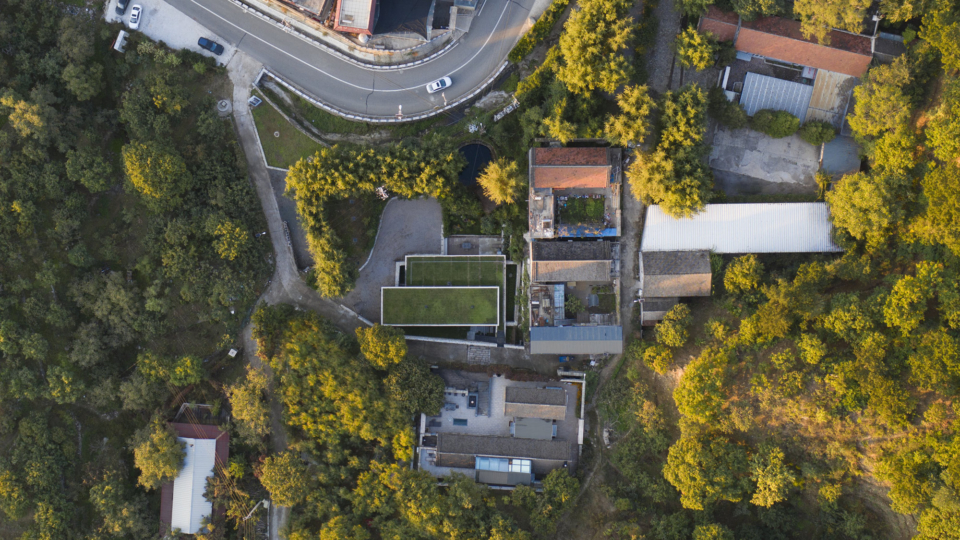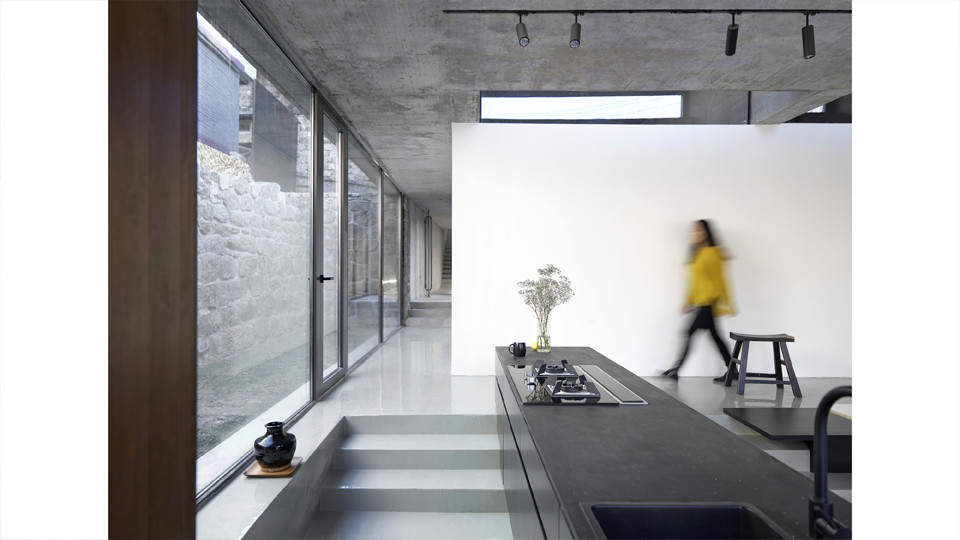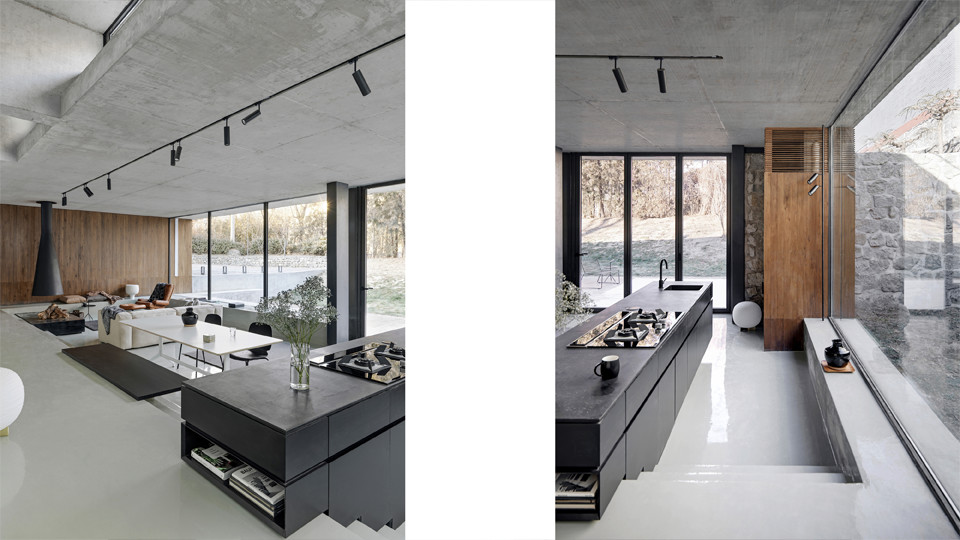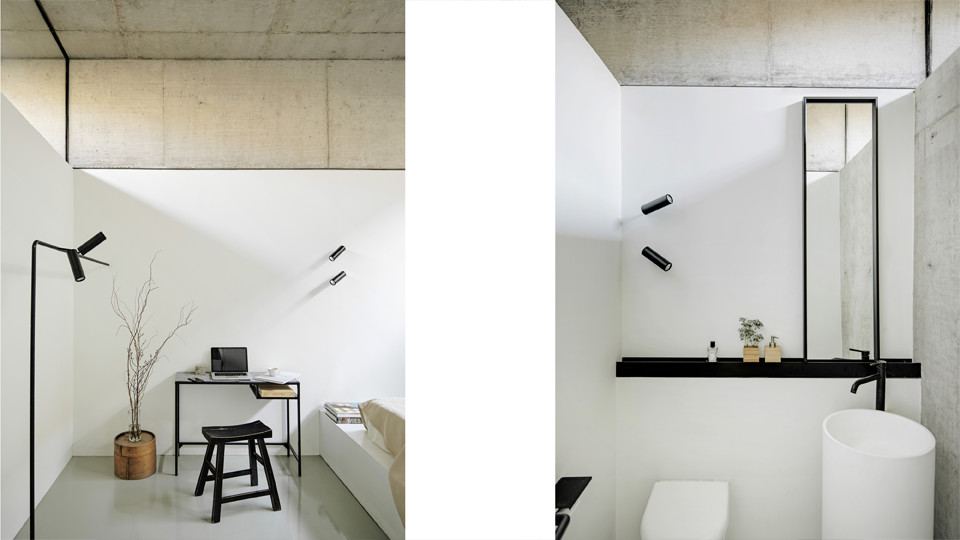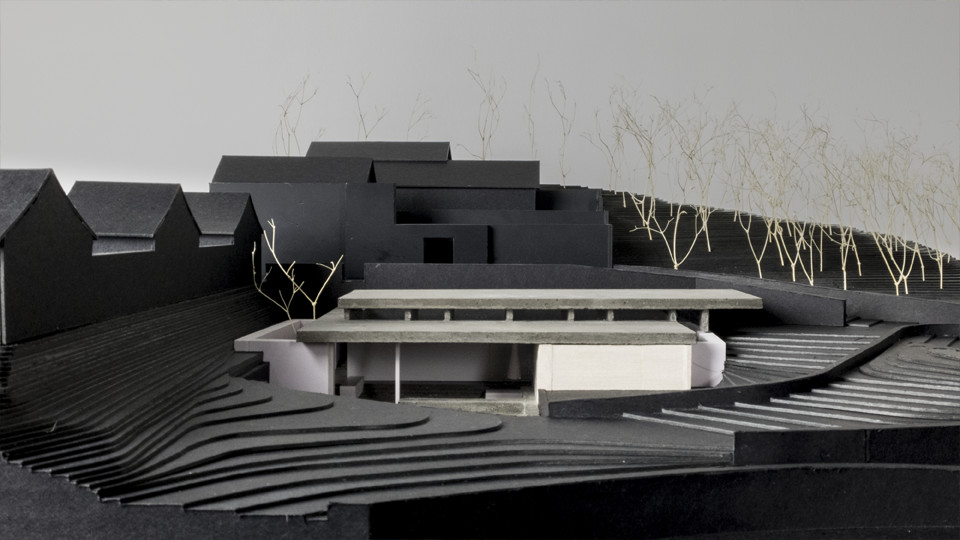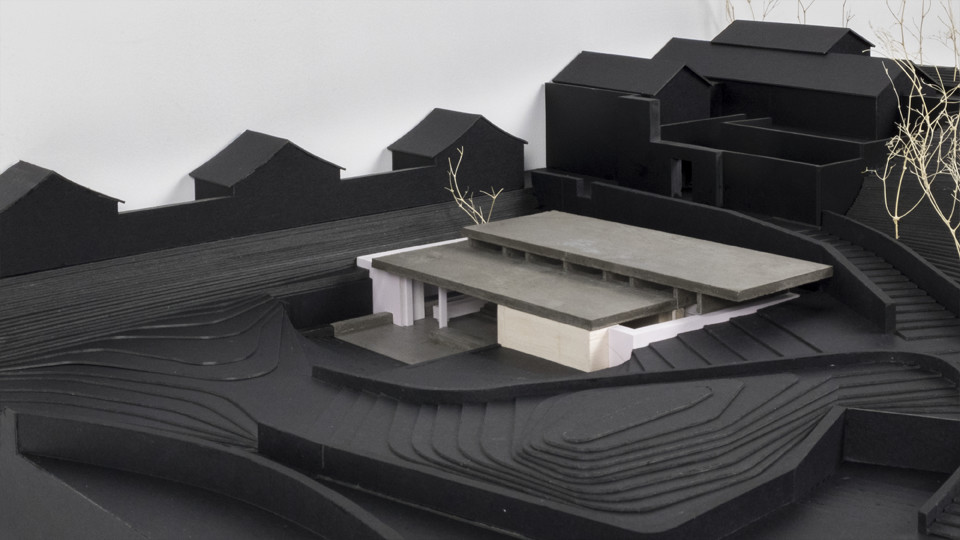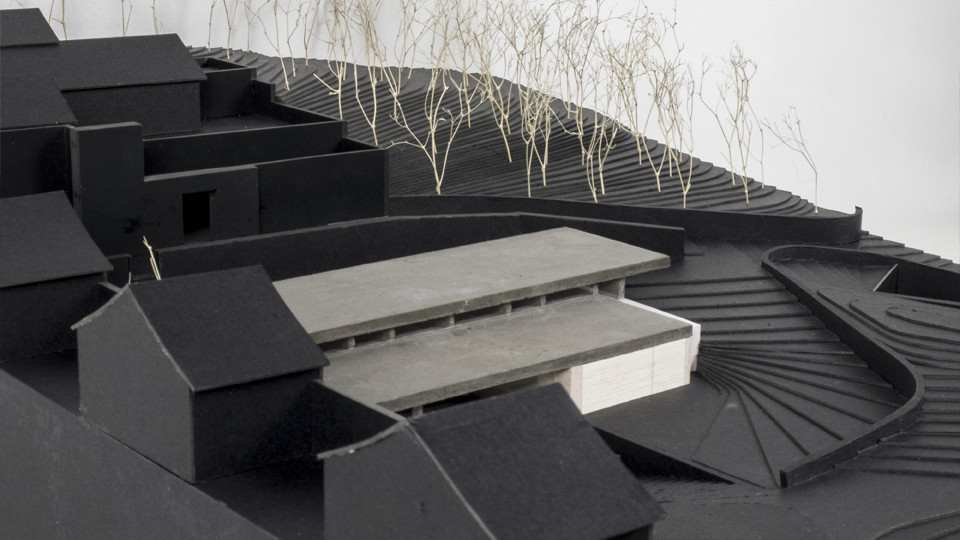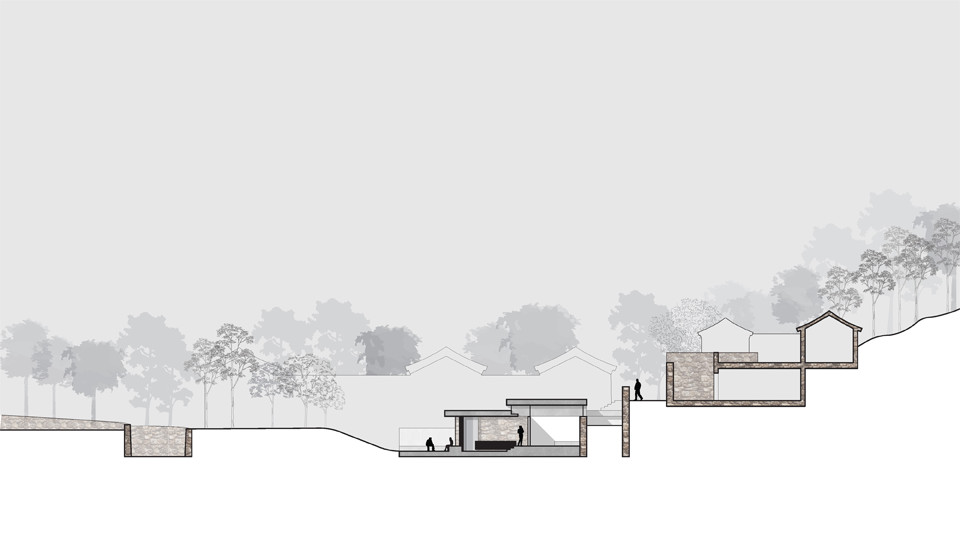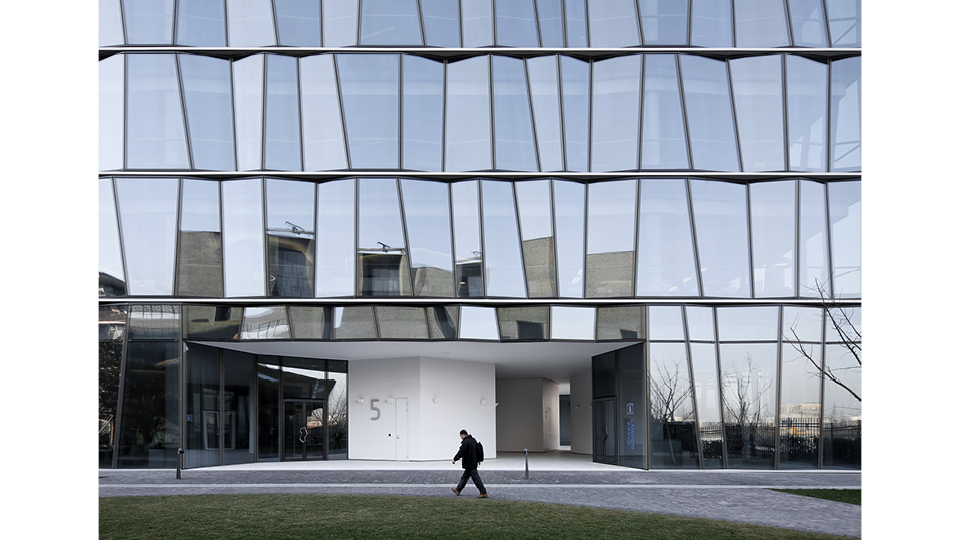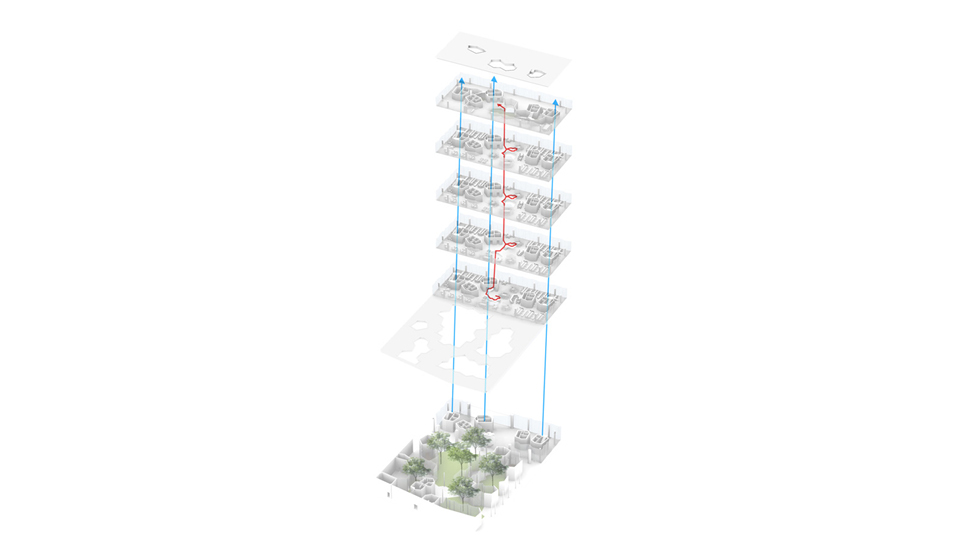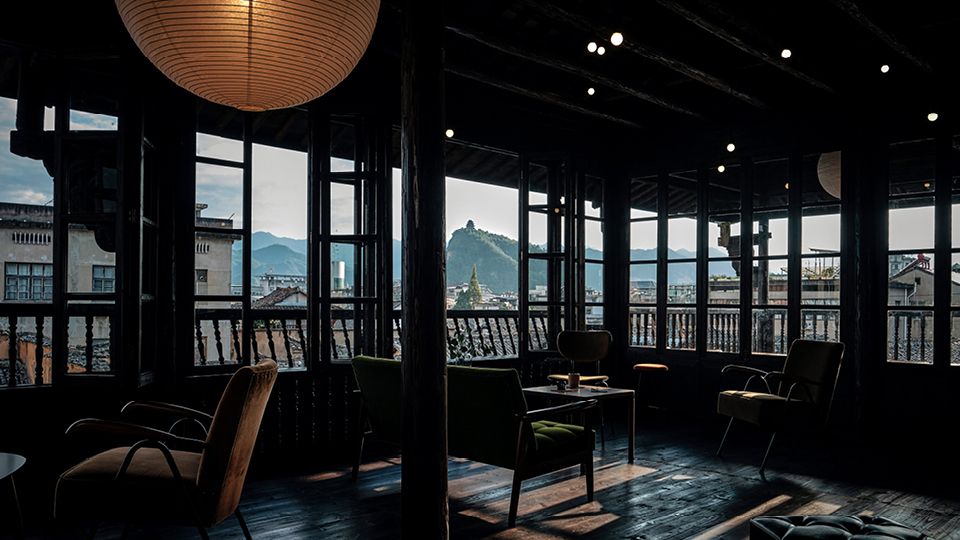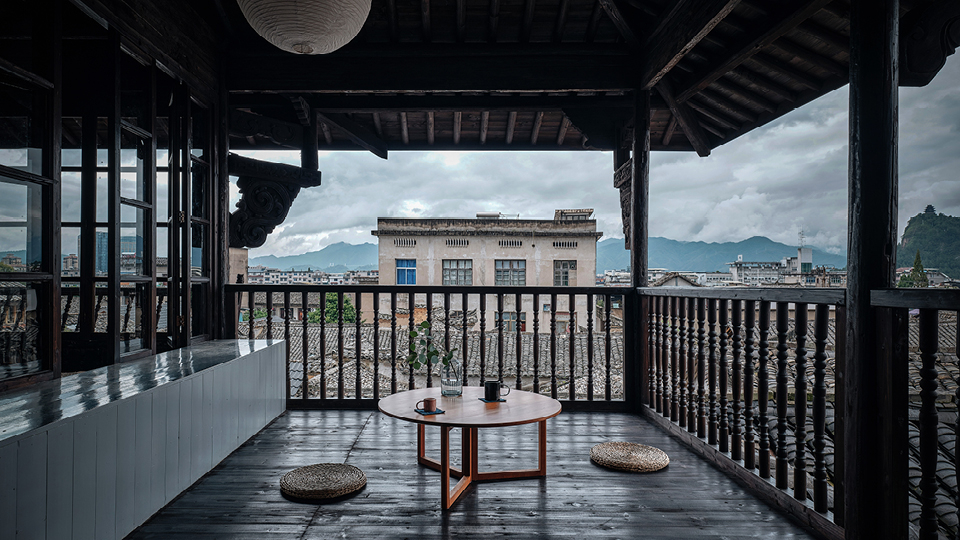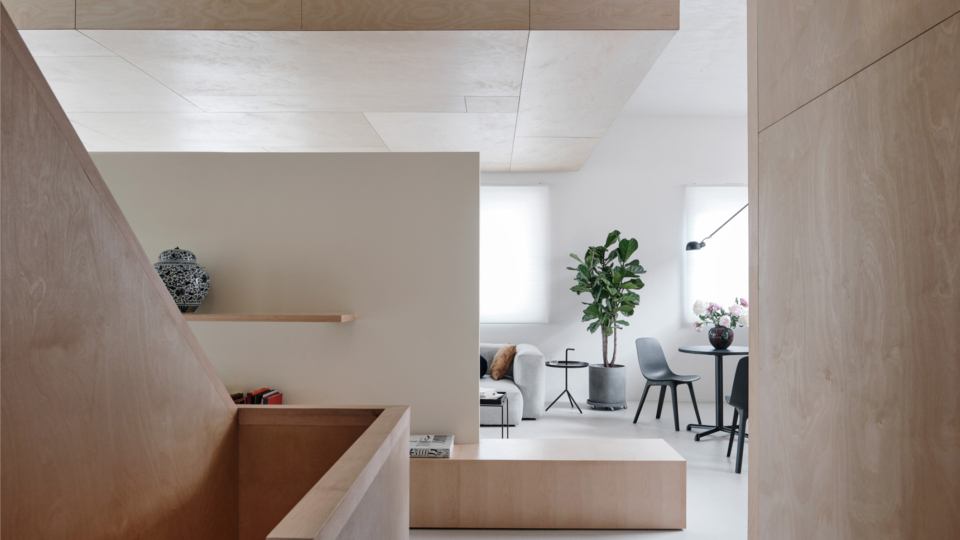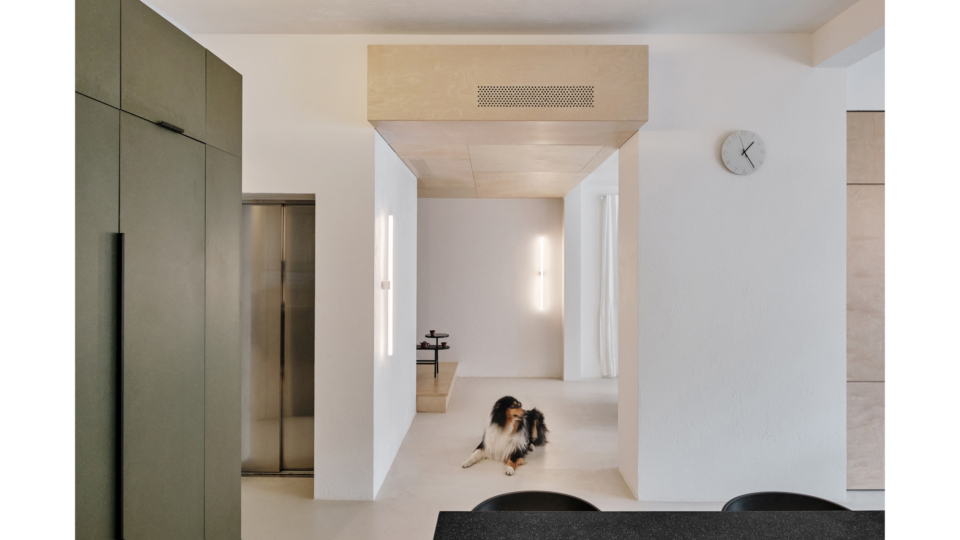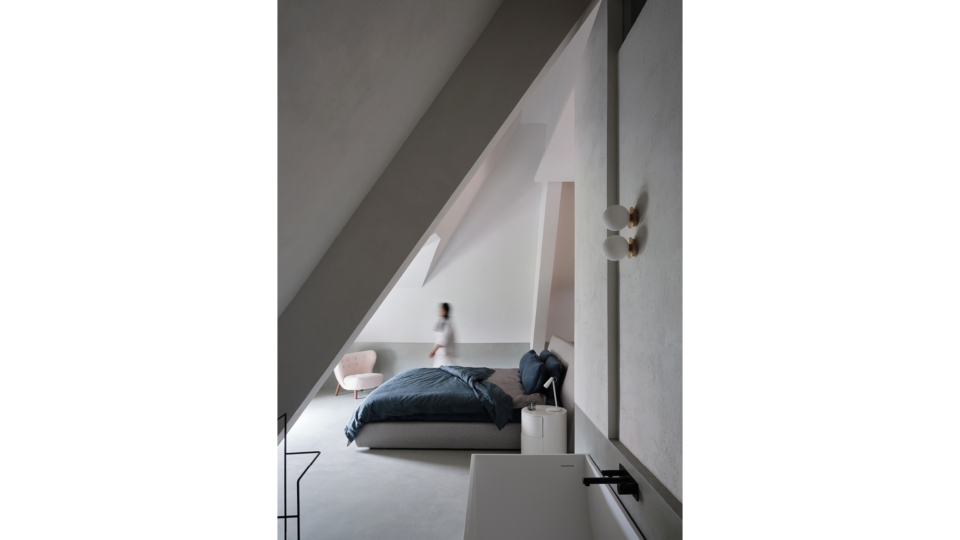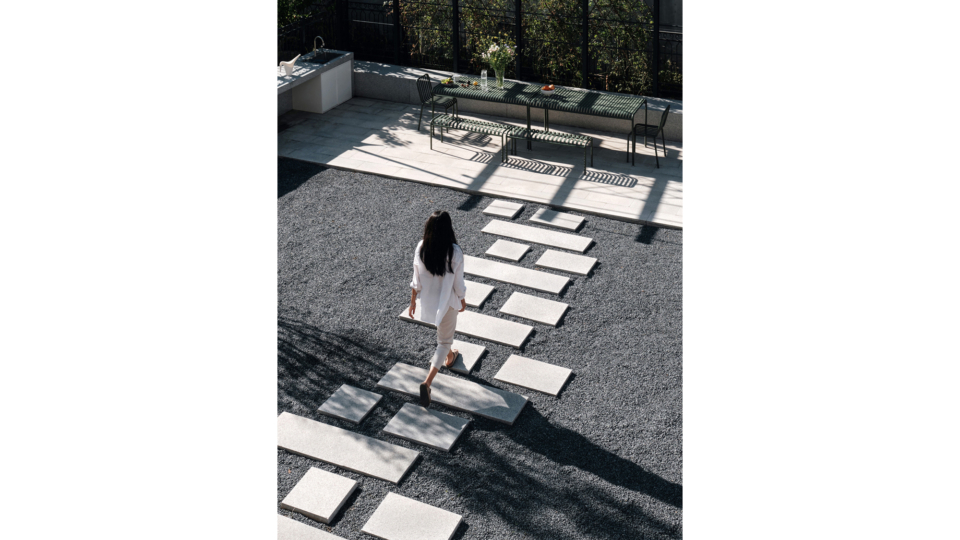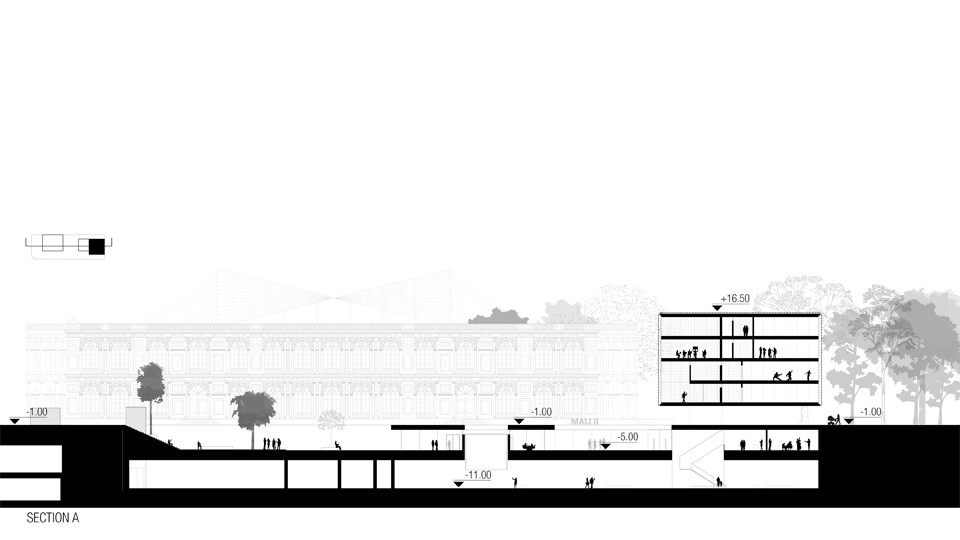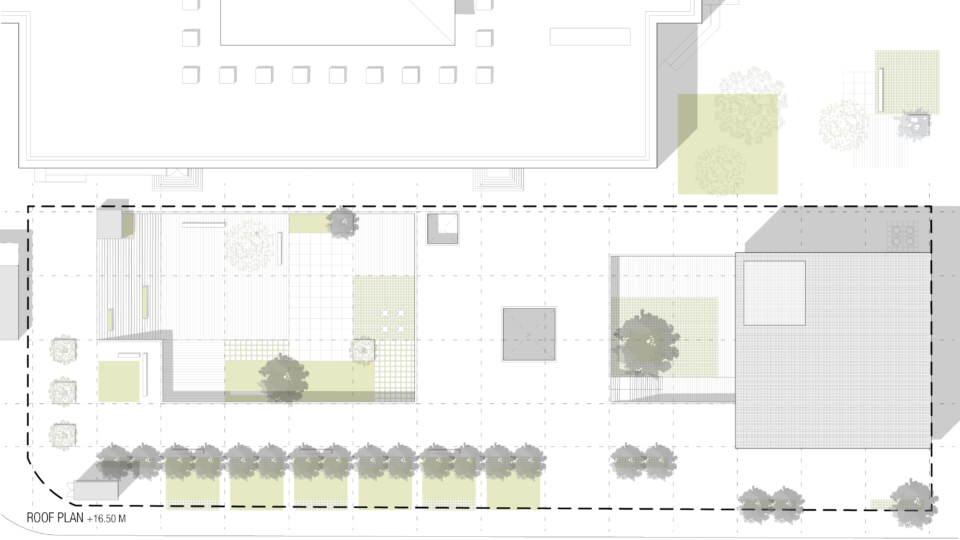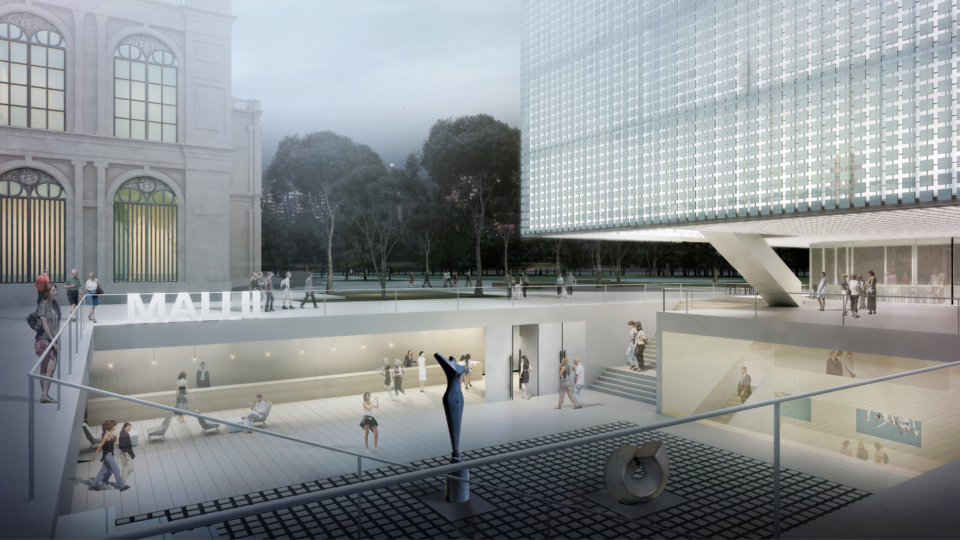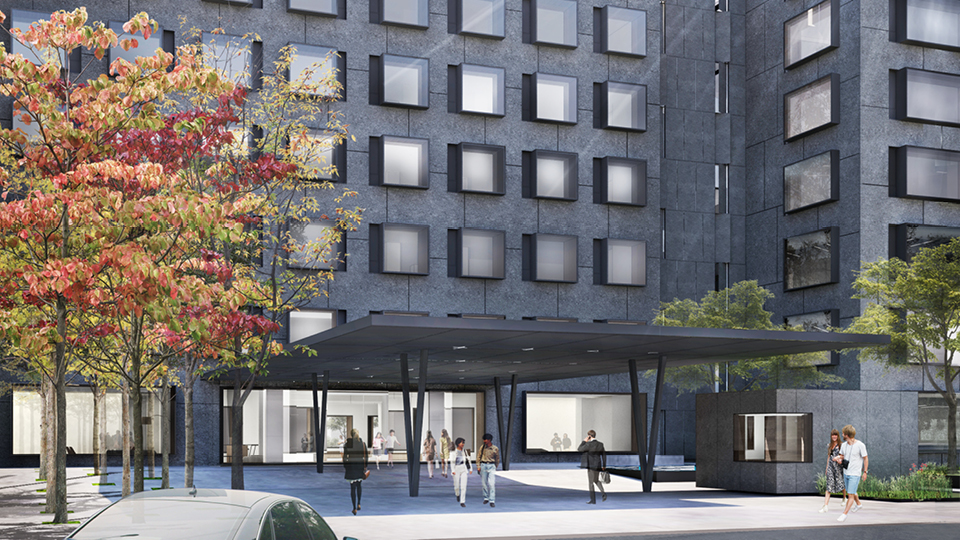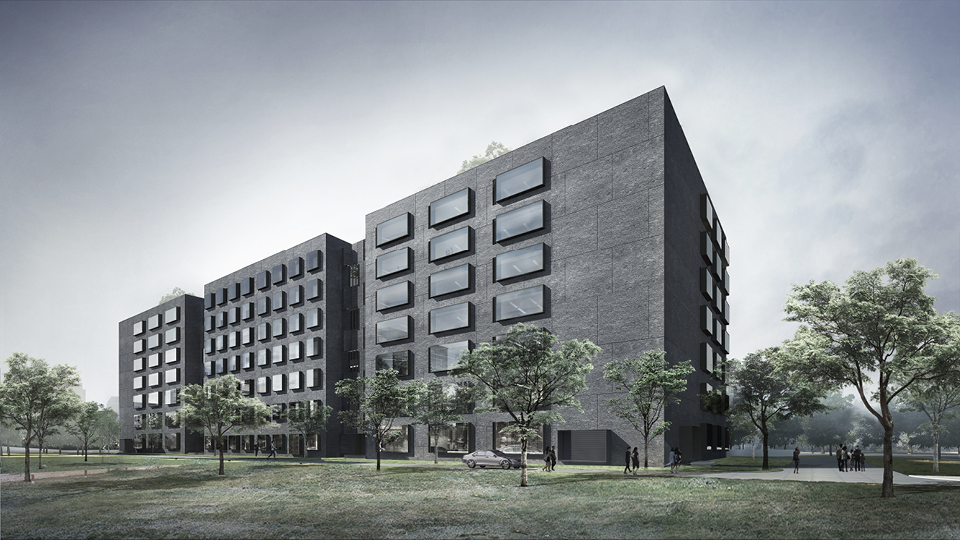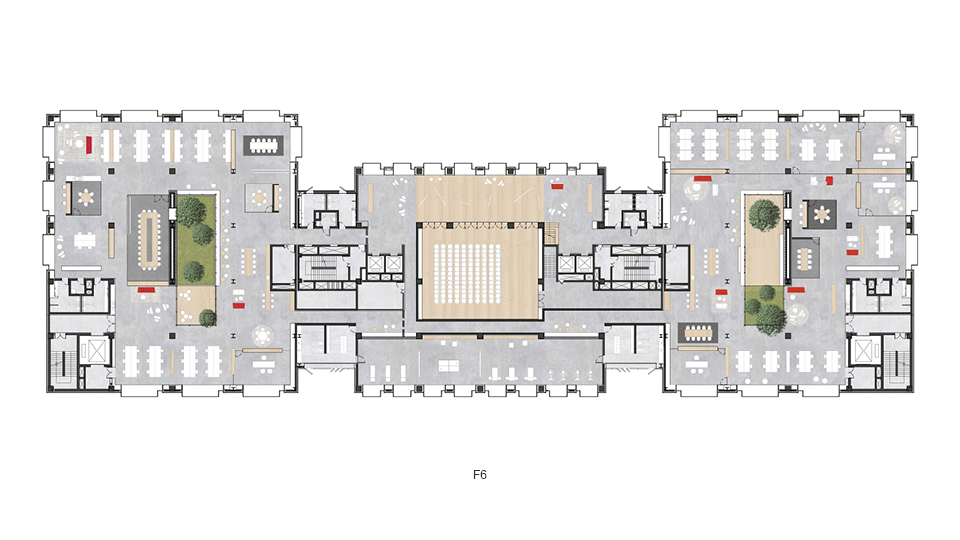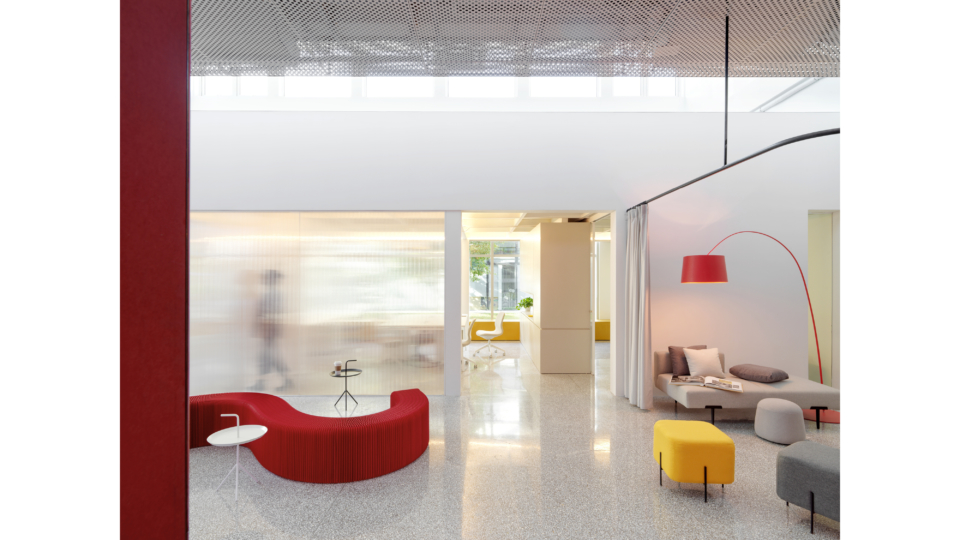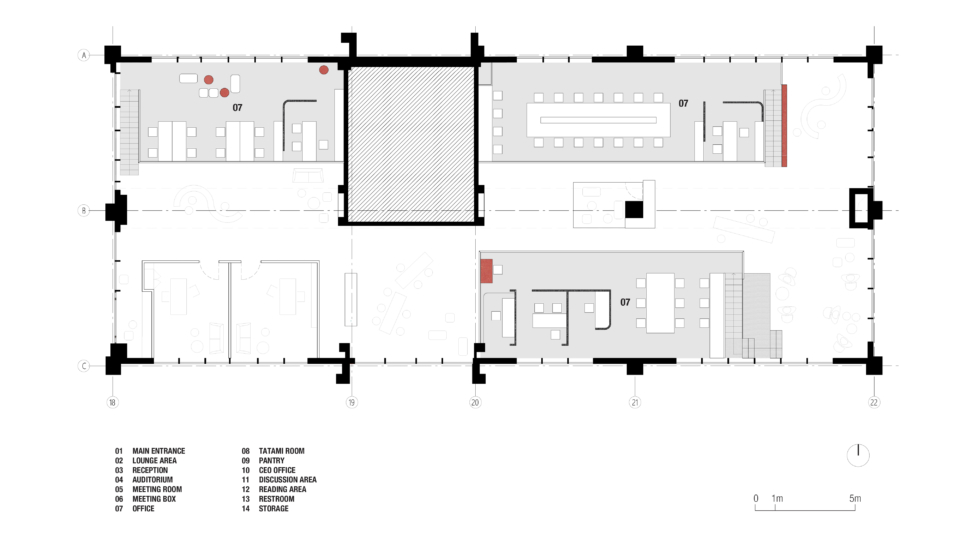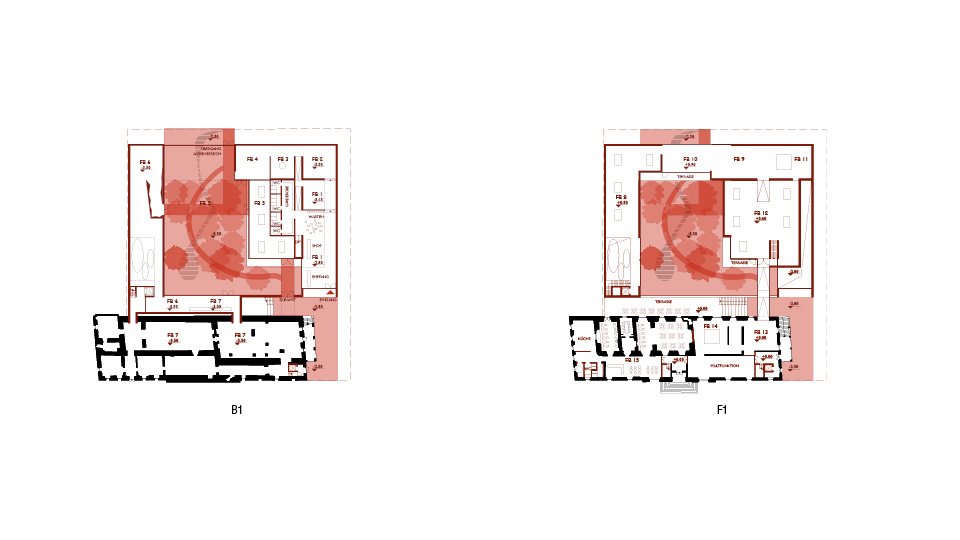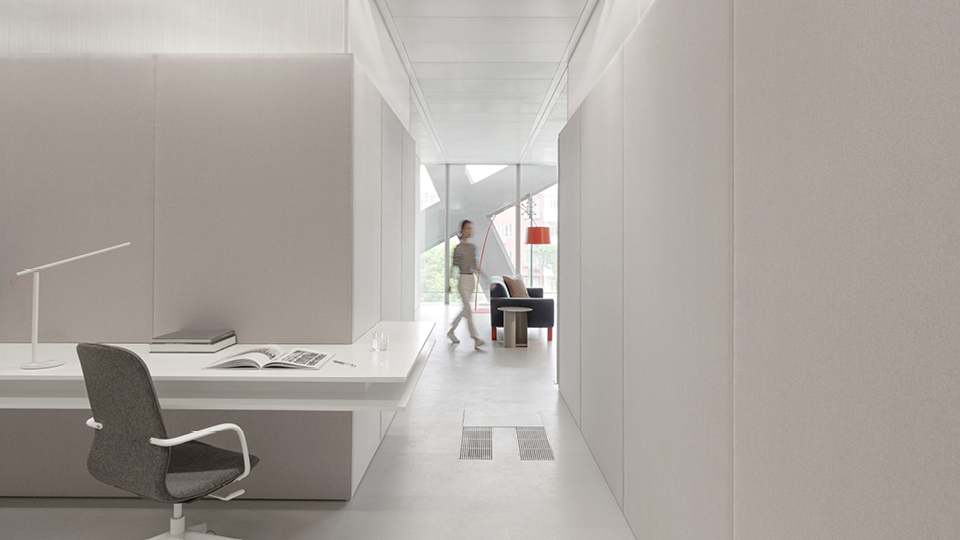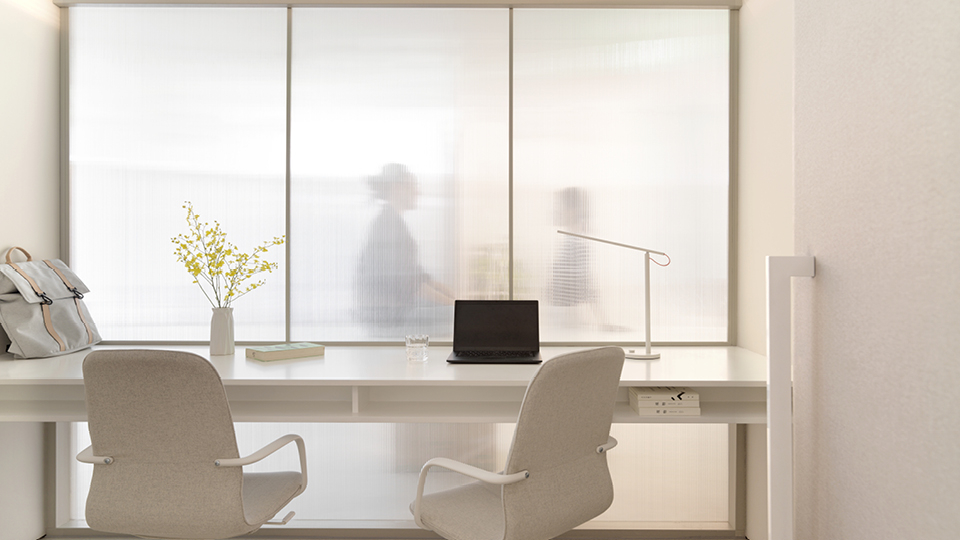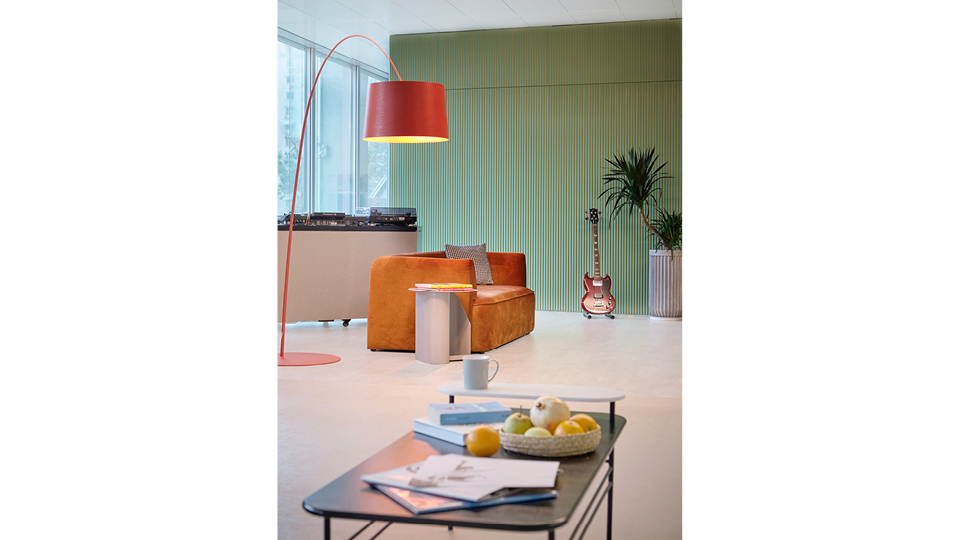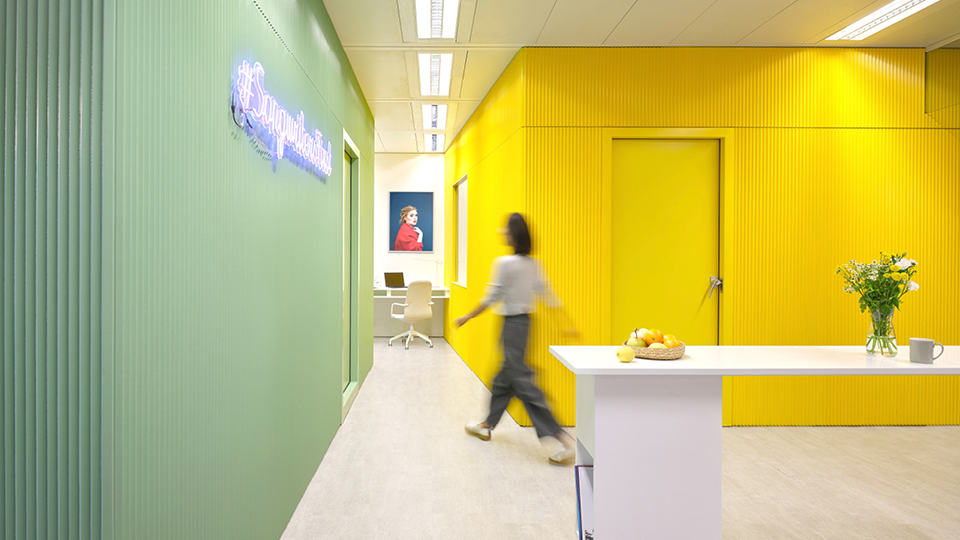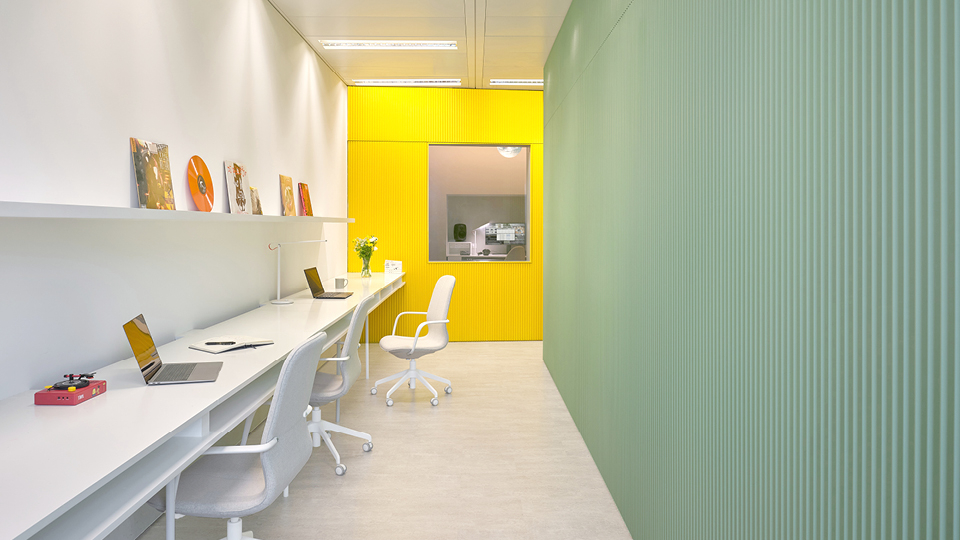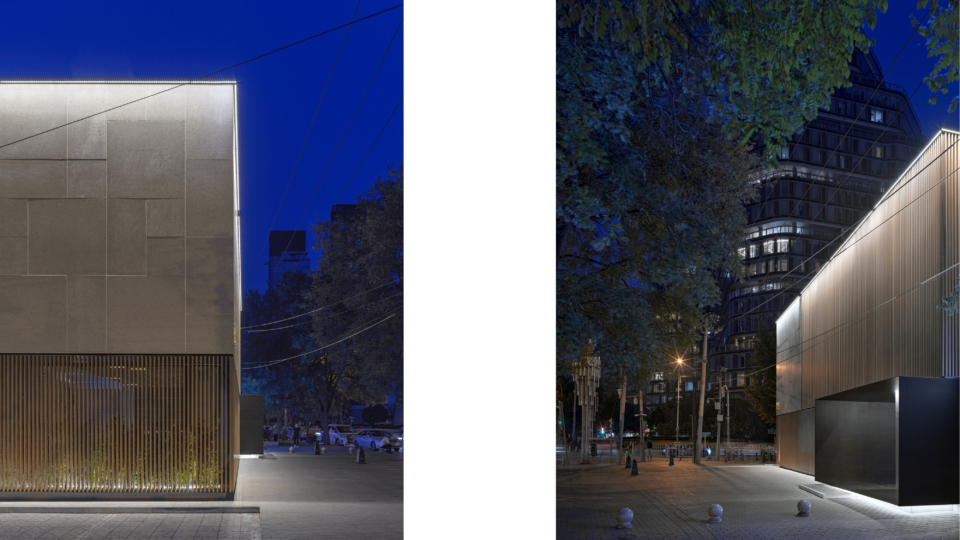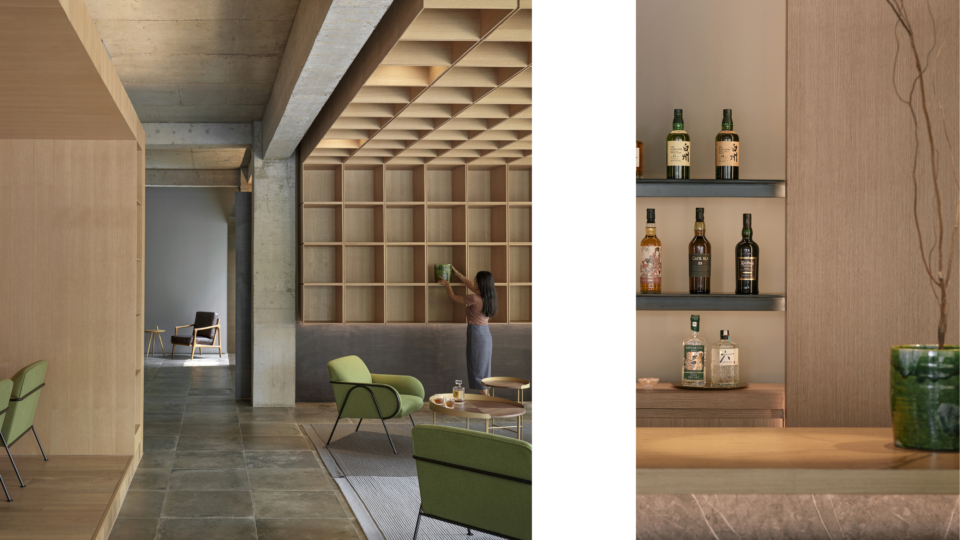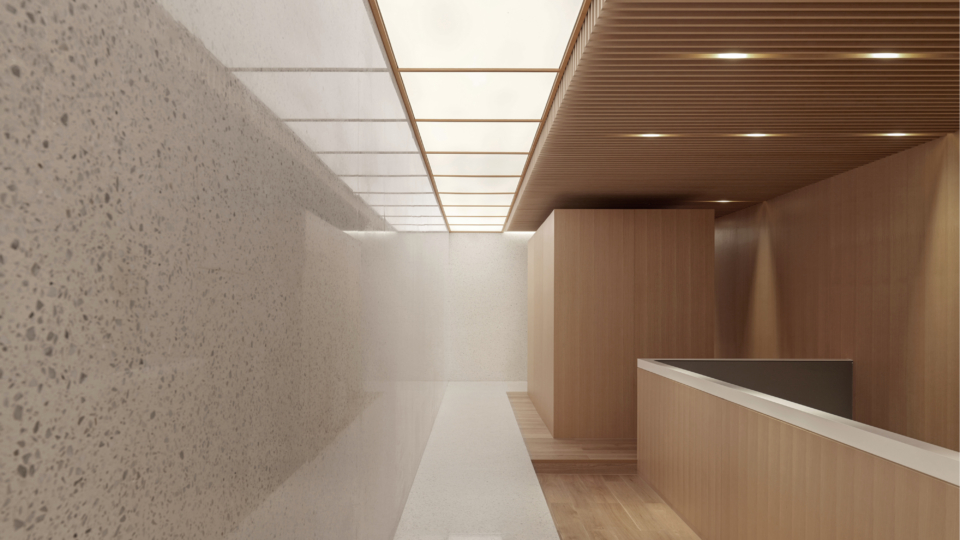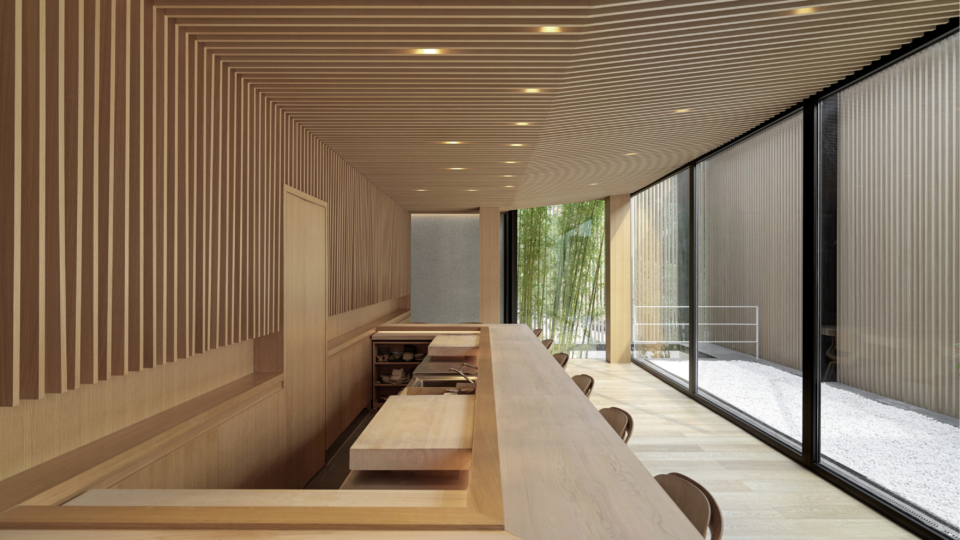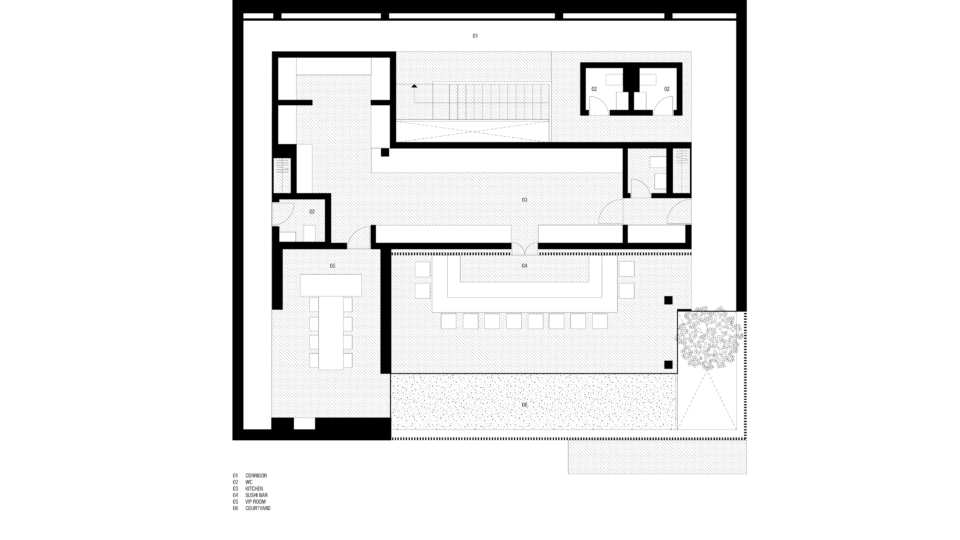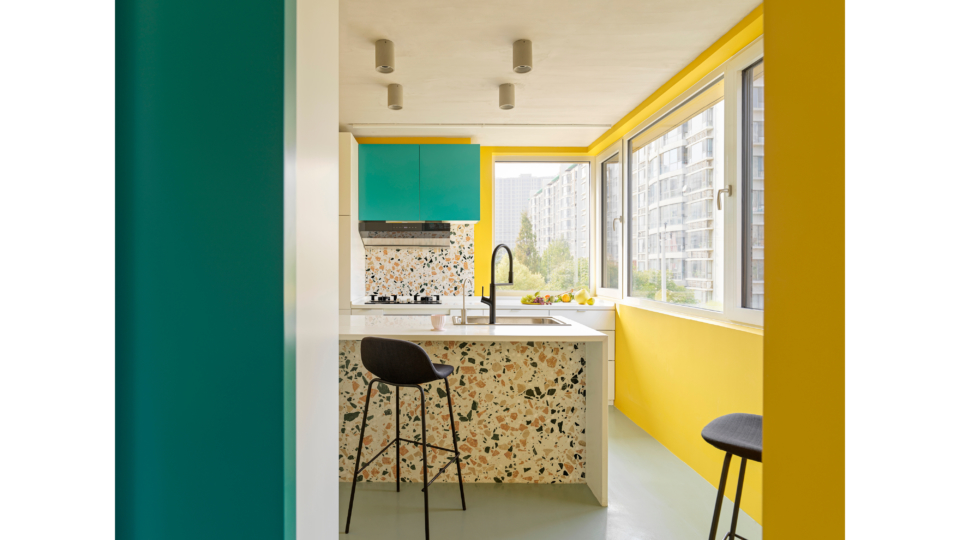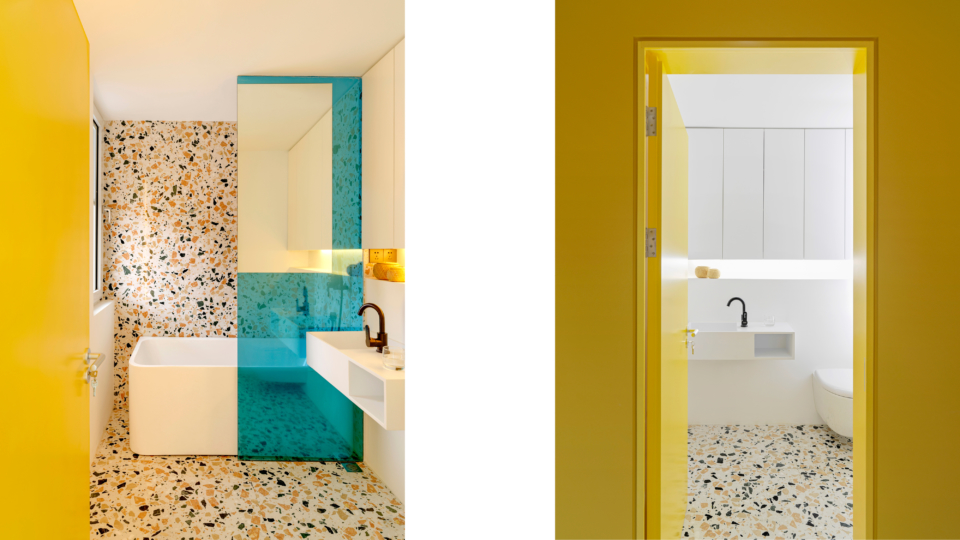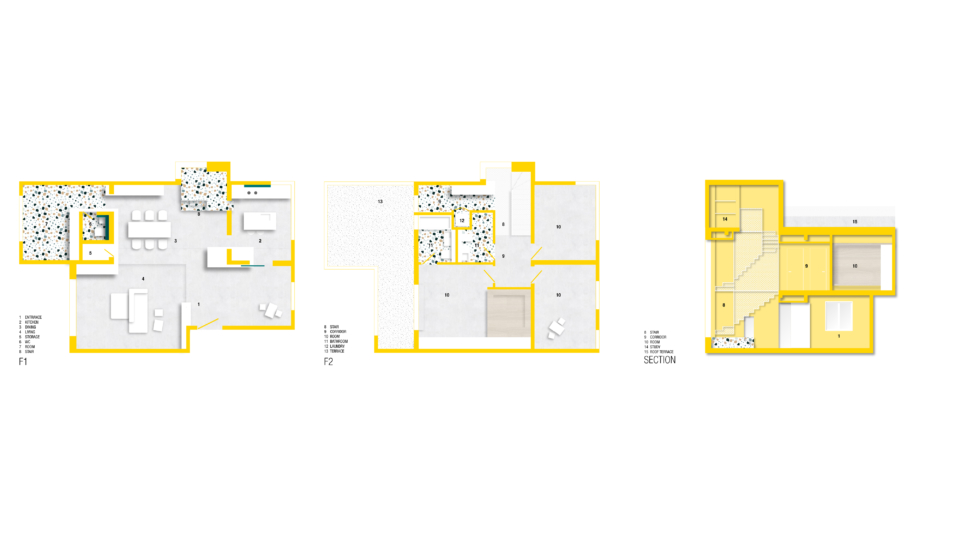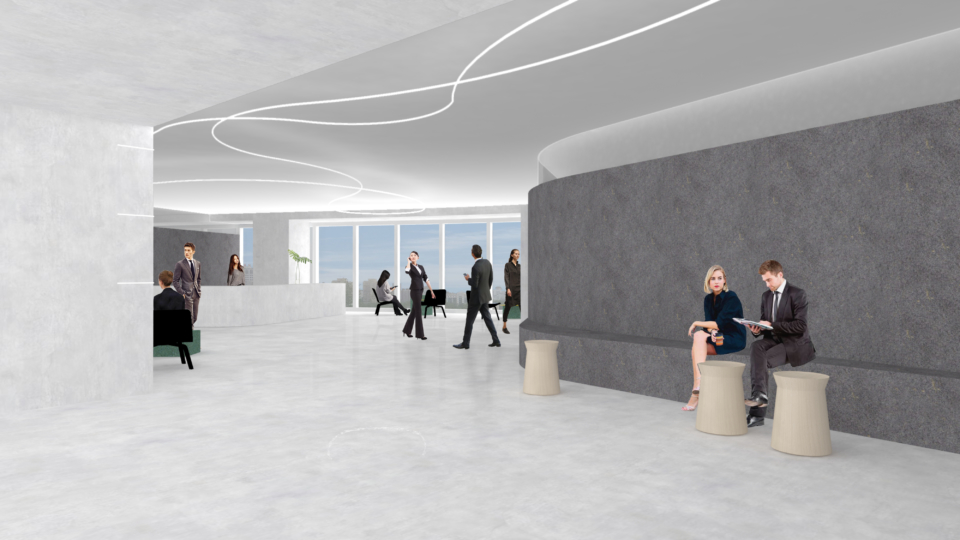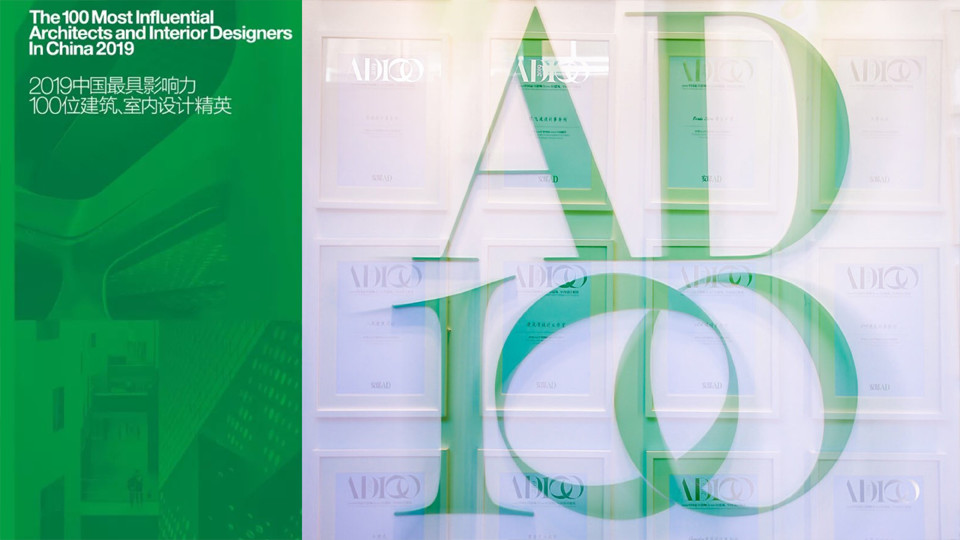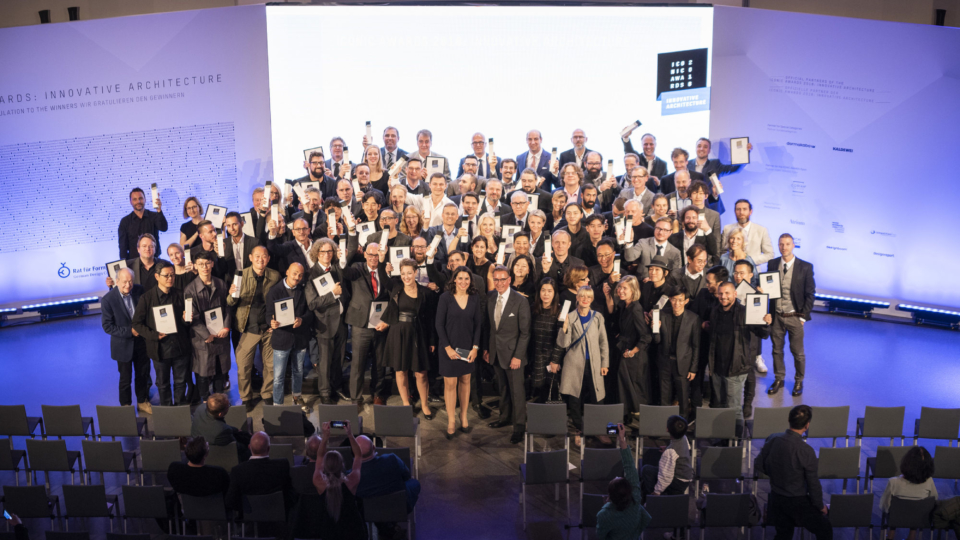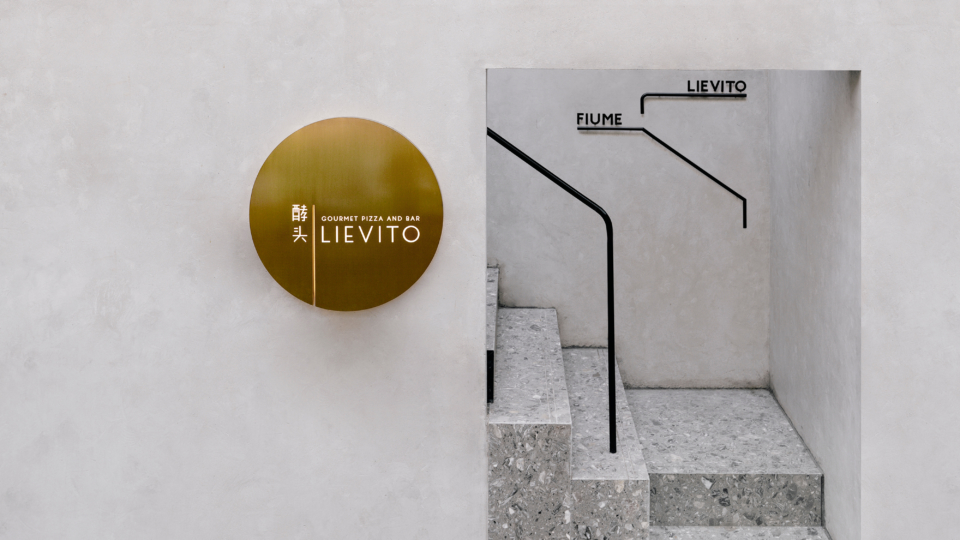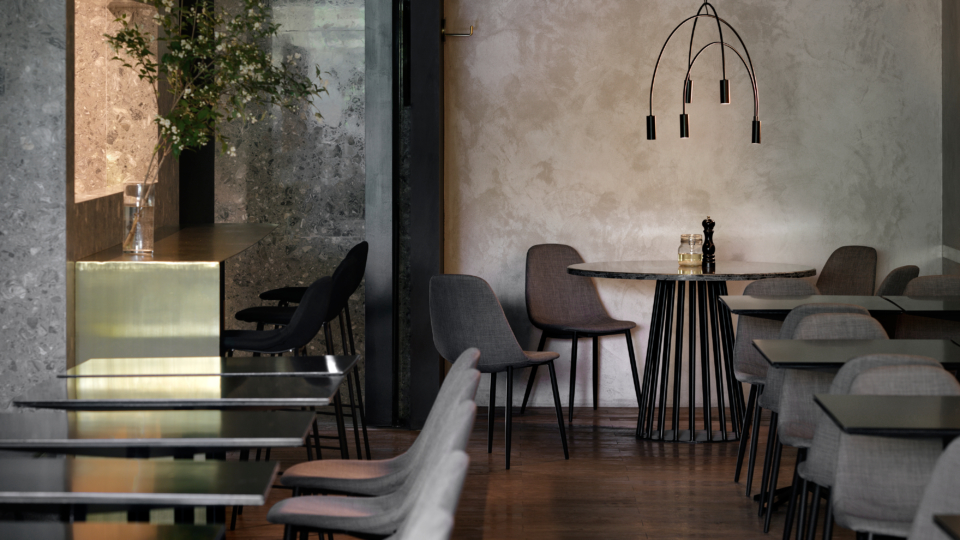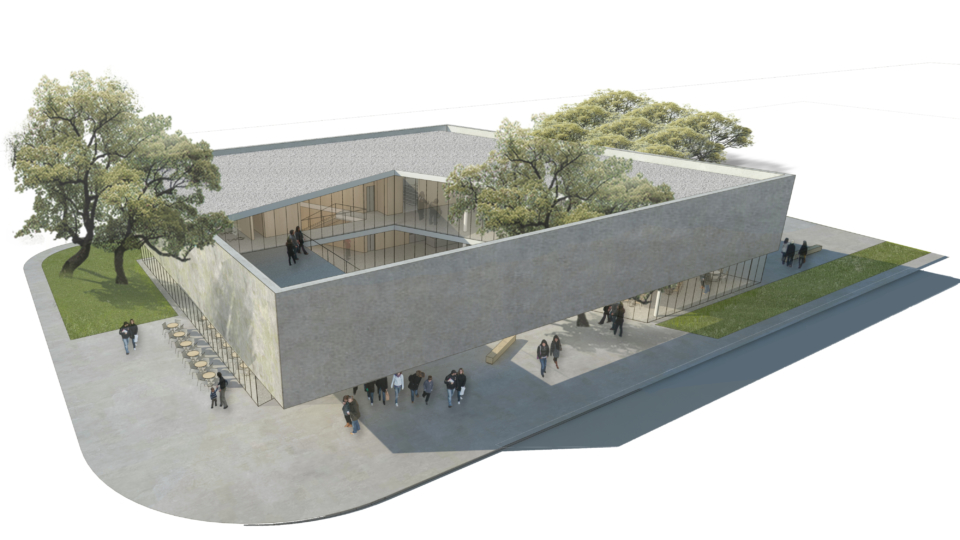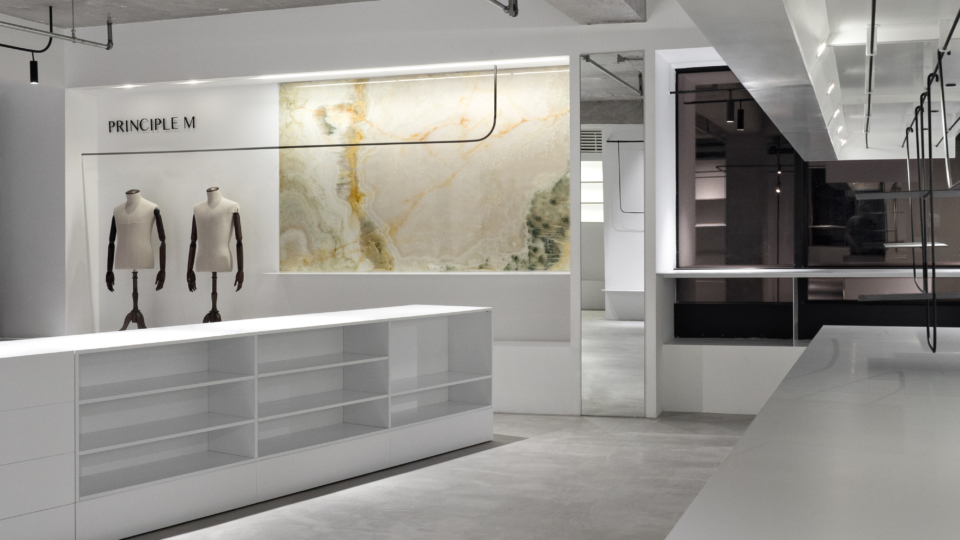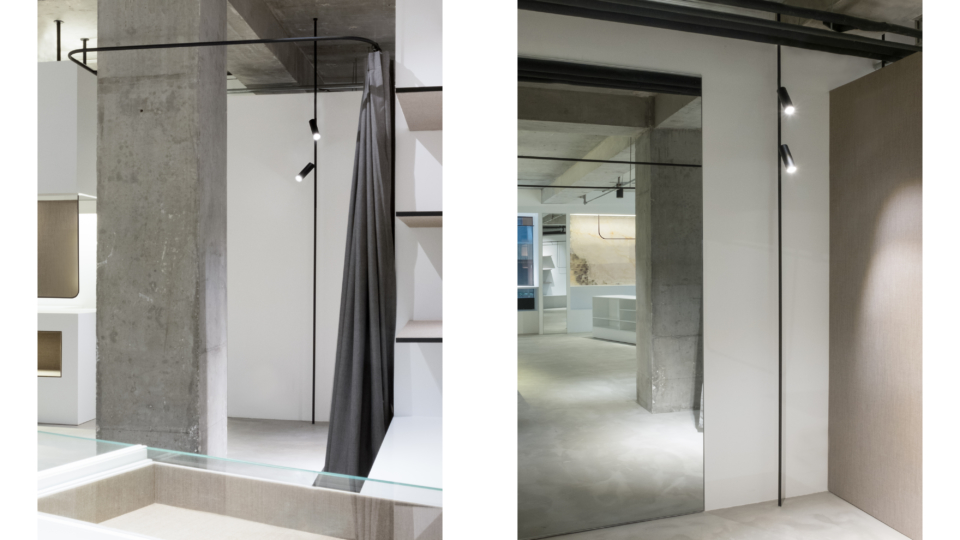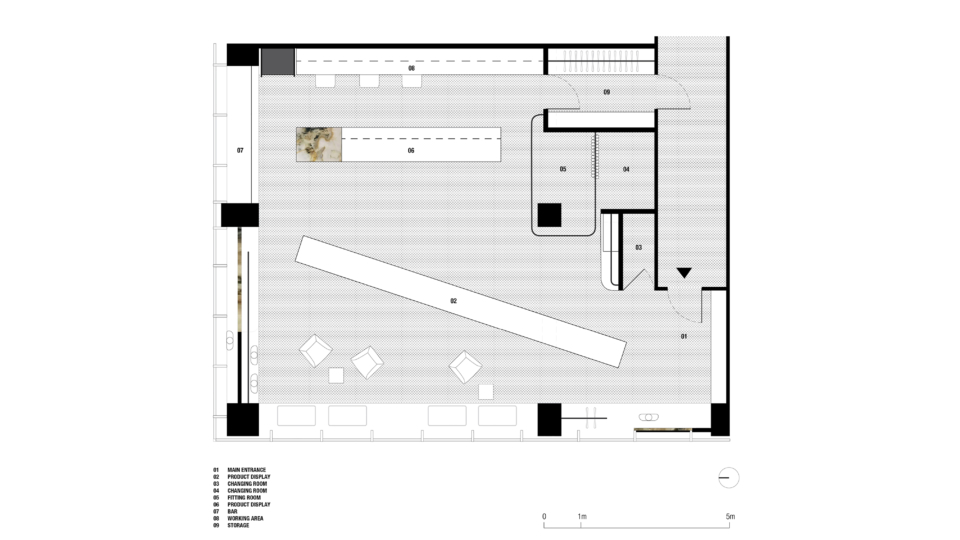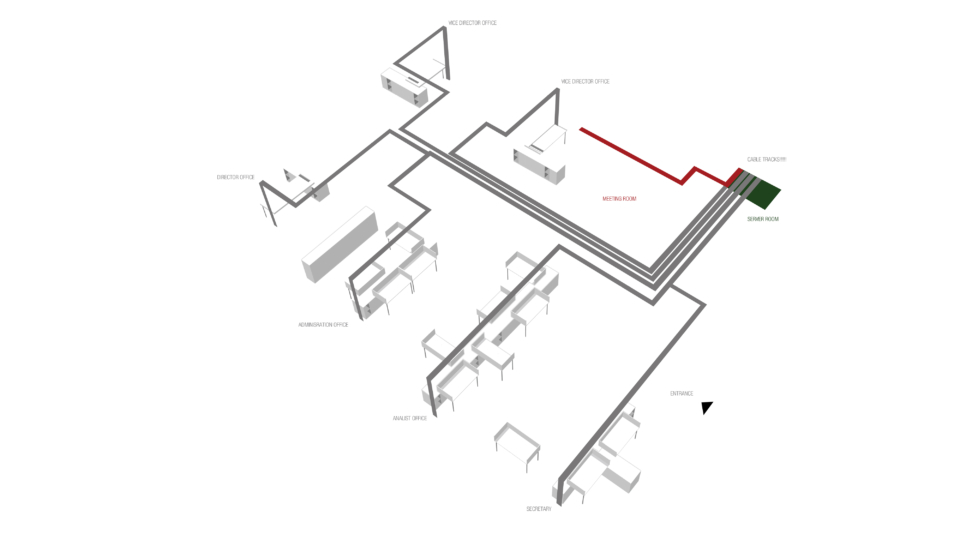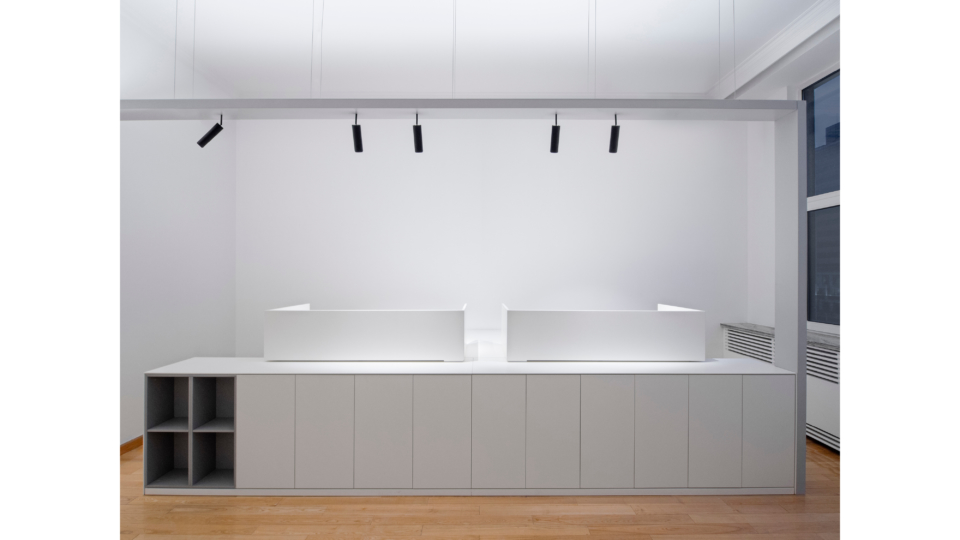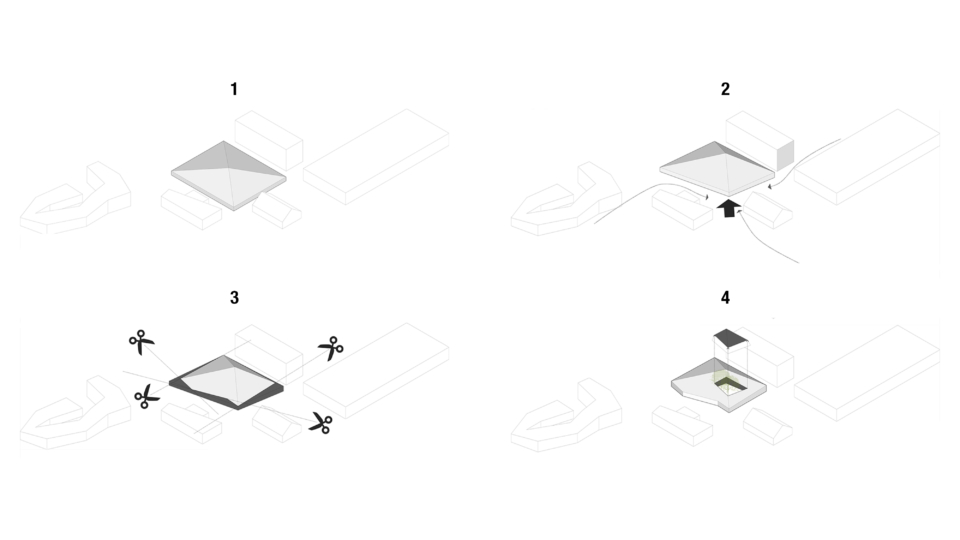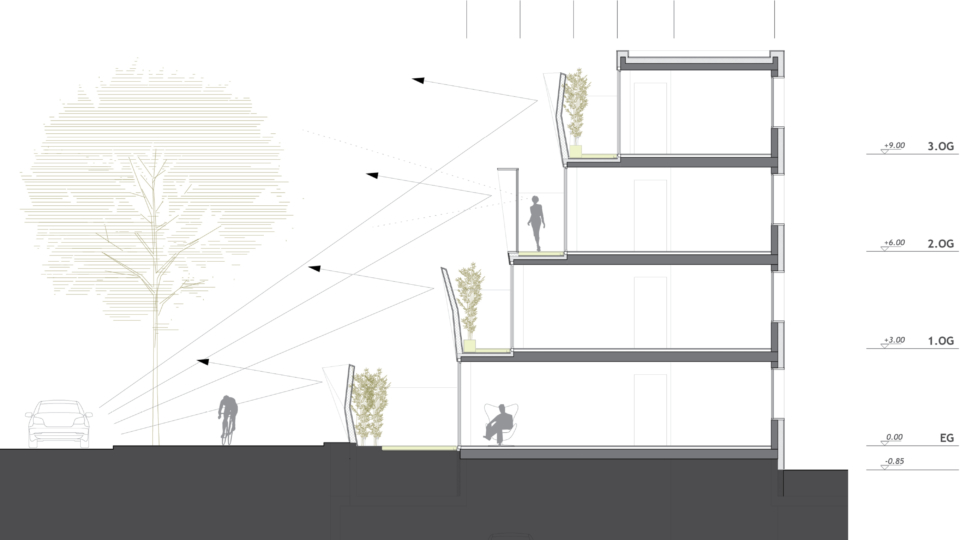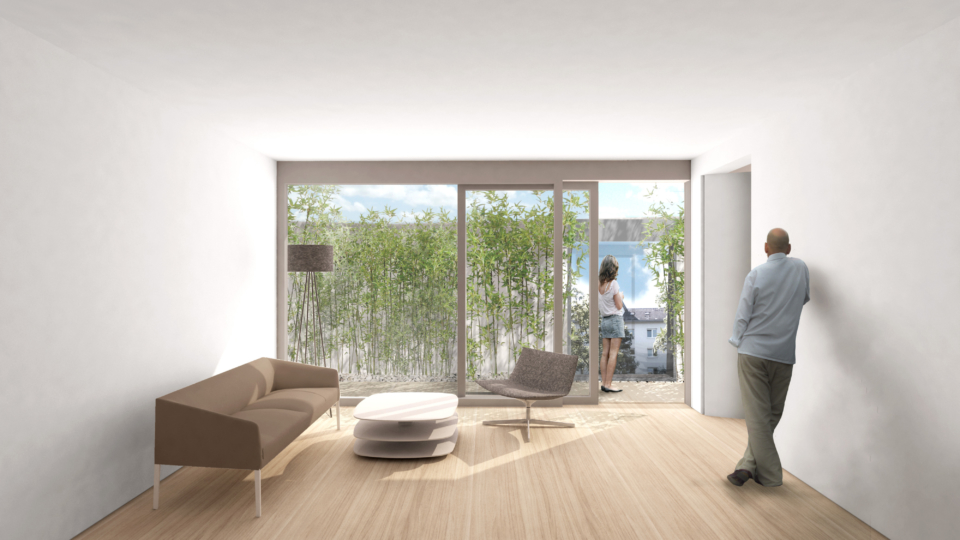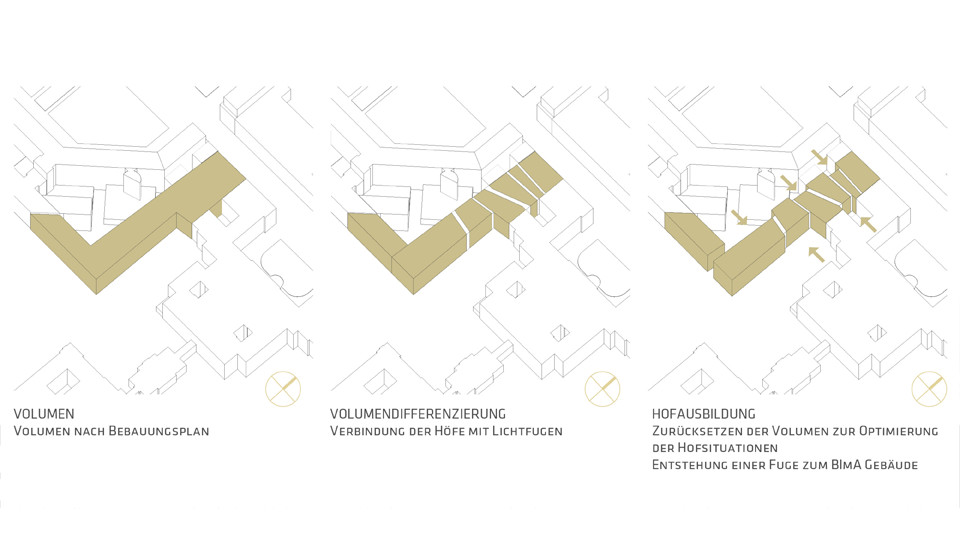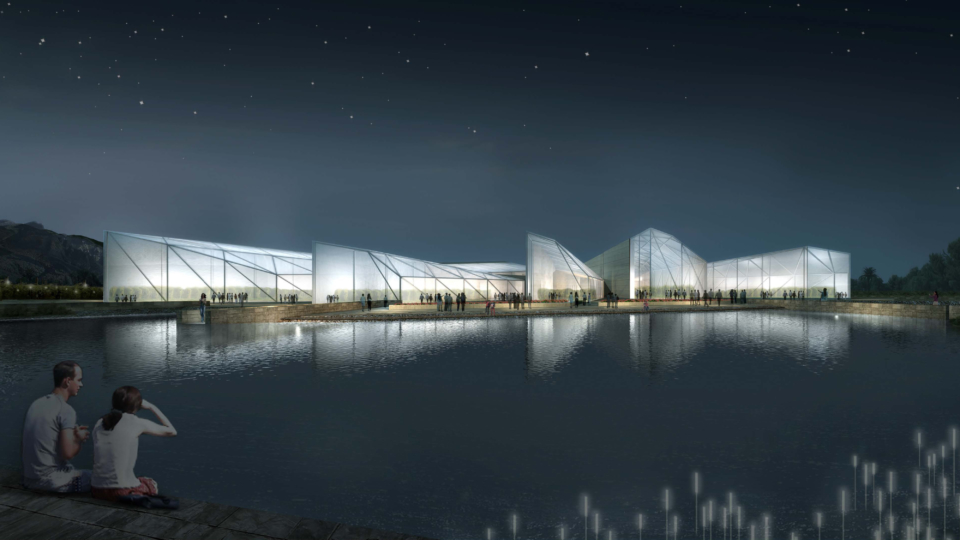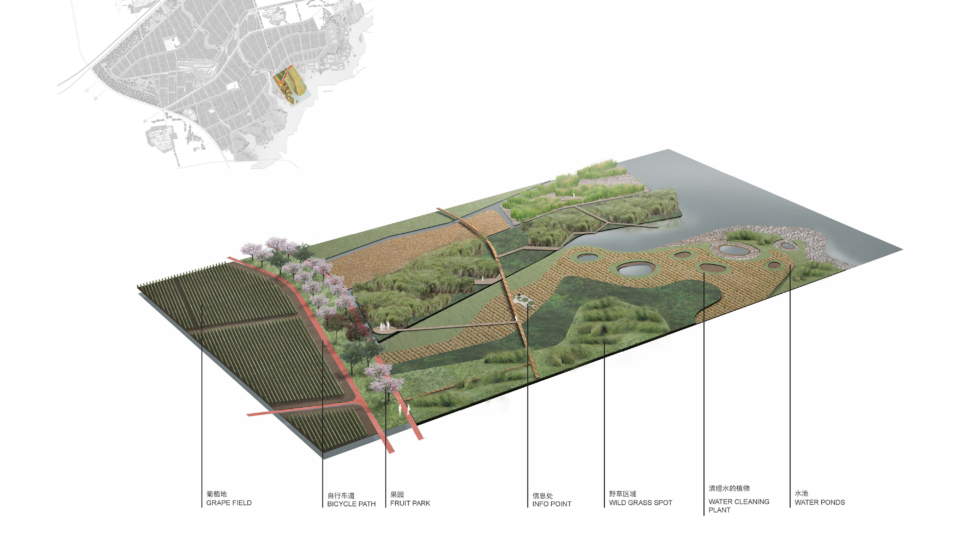HOUSE ON THE GREAT WALL
The property is located in a mountain area near the Great Wall, north of Beijing.
Originally built in the middle of last century as underground storage for fruit trees for the village, the existing structure is built entirely of natural stone and consists of a rectangular volume of 21x11x4 meters.
The client owns a house on the south side of the property, in an elevated position overlooking the roof of the underground storage. The scope of the design was to extend the existing house by turning the storage into a 4 bedrooms residence.
The existing storage is constructed north facing, partially underground in a basin lower than the surrounding. To create a livable environment for the new residence, a design solution for these particular conditions was required.
The design strategy focused on three main directions: enhance the identity of the storage and its stone walls, allow as much light as possible to the interior space and preserving the panoramic view from the existing house owned by the client.
The existing natural stone walls are preserved to a large extent and are fully exposed as a strong presence in the house in contrast with the new polished concrete structure and white plastered interior walls. Only in the north side the natural stone wall is replaced by a large glass façade and the soil removed to create a generous terrace in front, which occupies the entire length of the living and dining area in the inside. Also, in the north side, the garage is inset into the building as a wood cladded box.
In the open-plan living area, the custom-made open fireplace and the black kitchen counter set 2 focal points while the wood cladding of the garage provides a warm background to the soft seating area.
The new roof was designed to maximize the natural light input to the house. The existing roof was replaced by two concrete slabs, which are detached from the stone wall and set at two different heights. The lower northern roof covers the living room and the garage and it is designed as a roof terrace. It is shorter than the existing stone wall length and creates two gardens in the east and in the west of the house. These gardens increase the natural of light from different angles.
The higher roof in the south is shifted to the west to allow a passage to the lower roof terrace and avoid to project shadow to the east courtyard.
The different heights of the roofs are responding to in the terraced degradat...
The property is located in a mountain area near the Great Wall, north of Beijing.
Originally built in the middle of last century as underground storage for fruit trees for the village, the existing structure is built entirely of natural stone and consists of a rectangular volume of 21x11x4 meters.
The client owns a house on the south side of the property, in an elevated position overlooking the roof of the underground storage. The scope of the design was to extend the existing house by turning the storage into a 4 bedrooms residence.
The existing storage is constructed north facing, partially underground in a basin lower than the surrounding. To create a livable environment for the new residence, a design solution for these particular conditions was required.
The design strategy focused on three main directions: enhance the identity of the storage and its stone walls, allow as much light as possible to the interior space and preserving the panoramic view from the existing house owned by the client.
The existing natural stone walls are preserved to a large extent and are fully exposed as a strong presence in the house in contrast with the new polished concrete structure and white plastered interior walls. Only in the north side the natural stone wall is replaced by a large glass façade and the soil removed to create a generous terrace in front, which occupies the entire length of the living and dining area in the inside. Also, in the north side, the garage is inset into the building as a wood cladded box.
In the open-plan living area, the custom-made open fireplace and the black kitchen counter set 2 focal points while the wood cladding of the garage provides a warm background to the soft seating area.
The new roof was designed to maximize the natural light input to the house. The existing roof was replaced by two concrete slabs, which are detached from the stone wall and set at two different heights. The lower northern roof covers the living room and the garage and it is designed as a roof terrace. It is shorter than the existing stone wall length and creates two gardens in the east and in the west of the house. These gardens increase the natural of light from different angles.
The higher roof in the south is shifted to the west to allow a passage to the lower roof terrace and avoid to project shadow to the east courtyard.
The different heights of the roofs are responding to in the terraced degradation of the plot and the surrounding. The gap in between the 2 roofs allows more natural light to penetrate in the central part of the building and it is improving the natural ventilation during the warm seasons.
Below the higher roof in the south part of the new house are located the bedrooms. They enjoy a contemplative feeling thanks to their high ceilings and high-rise windows. Each room has a private bathroom. The bedrooms are connected by a passage which is elevated by three steps to the adjacent living area.
Next to the bedrooms, in the southeast corner, a tunnel connects the new house with to the existing residential building. As the belonging plots are separated by a side road, this passage passes through a tunnel under the road.
As a result, for the view from the terrace of the existing house is enriched by two floating green roofs in balance with the panoramic scene to the Great Wall.
Design Team:
Margret Domko, Momo Andrea Destro, Amirlin Sunderiya
Photo:
Jonathan Leijonhufvud
RESIDENTIAL | 2019 | BEIJING | CHINA
The property is located in a mountain area near the Great Wall, north of Beijing.
Originally built in the middle of last century as underground storage for fruit trees for the village, the existing structure is built entirely of natural stone and consists of a rectangular volume of 21x11x4 meters.
The client owns a house on the south side of the property, in an elevated position overlooking the roof of the underground storage. The scope of the design was to extend the existing house by turning the storage into a 4 bedrooms residence.
The existing storage is constructed north facing, partially underground in a basin lower than the surrounding. To create a livable environment for the new residence, a design solution for these particular conditions was required.
The design strategy focused on three main directions: enhance the identity of the storage and its stone walls, allow as much light as possible to the interior space and preserving the panoramic view from the existing house owned by the client.
The existing natural stone walls are preserved to a large extent and are fully exposed as a strong presence in the house in contrast with the new polished concrete structure and white plastered interior walls. Only in the north side the natural stone wall is replaced by a large glass façade and the soil removed to create a generous terrace in front, which occupies the entire length of the living and dining area in the inside. Also, in the north side, the garage is inset into the building as a wood cladded box.
In the open-plan living area, the custom-made open fireplace and the black kitchen counter set 2 focal points while the wood cladding of the garage provides a warm background to the soft seating area.
The new roof was designed to maximize the natural light input to the house. The existing roof was replaced by two concrete slabs, which are detached from the stone wall and set at two different heights. The lower northern roof covers the living room and the garage and it is designed as a roof terrace. It is shorter than the existing stone wall length and creates two gardens in the east and in the west of the house. These gardens increase the natural of light from different angles.
The higher roof in the south is shifted to the west to allow a passage to the lower roof terrace and avoid to project shadow to the east courtyard.
The different heights of the roofs are responding to in the terraced degradation of the plot and the surrounding. The gap in between the 2 roofs allows more natural light to penetrate in the central part of the building and it is improving the natural ventilation during the warm seasons.
Below the higher roof in the south part of the new house are located the bedrooms. They enjoy a contemplative feeling thanks to their high ceilings and high-rise windows. Each room has a private bathroom. The bedrooms are connected by a passage which is elevated by three steps to the adjacent living area.
Next to the bedrooms, in the southeast corner, a tunnel connects the new house with to the existing residential building. As the belonging plots are separated by a side road, this passage passes through a tunnel under the road.
As a result, for the view from the terrace of the existing house is enriched by two floating green roofs in balance with the panoramic scene to the Great Wall.
Design Team:
Margret Domko, Momo Andrea Destro, Amirlin Sunderiya
Photo:
Jonathan Leijonhufvud
C10 TOWER
Building C10 is a 8400 sqm office in Novartis Campus in Shanghai designed in collaboration with ZAO/Standardarchitecture. The design is based on a cellular grid, which reflects the biotechnical research approach of Novartis. The building is divided in a 6 floors tower and a 1 floor courtyard building south of the tower, which is composed by 5 gardens in different size and plantation. Here several meeting and event rooms are located, as well as a VIP office and a tea house.
In the tower 220 working places are provided in a creative and flexible office layout.
The typical floor is zoned by 5 cores in irregular shapes and the central stair case, which invites to extend communication in between the floors.
The full glazed facade is designed according the cellular concept. Various panels of different sizes and different vertical and horizontal tilting angles creating a vibrant pattern from inside out and outside in views.
Building C10 is a 8400 sqm office in Novartis Campus in Shanghai designed in collaboration with ZAO/Standardarchitecture. The design is based on a cellular grid, which reflects the biotechnical research approach of Novartis. The building is divided in a 6 floors tower and a 1 floor courtyard building south of the tower, which is composed by 5 gardens in different size and plantation. Here several meeting and event rooms are located, as well as a VIP office and a tea house.
In the tower 220 working places are provided in a creative and flexible office layout.
The typical floor is zoned by 5 cores in irregular shapes and the central stair case, which invites to extend communication in between the floors.
The full glazed facade is designed according the cellular concept. Various panels of different sizes and different vertical and horizontal tilting angles creating a vibrant pattern from inside out and outside in views.
OFFICE | 2016 | SHANGHAI | CHINA | In collaboration with ZAO/Standardarchitecture
Building C10 is a 8400 sqm office in Novartis Campus in Shanghai designed in collaboration with ZAO/Standardarchitecture. The design is based on a cellular grid, which reflects the biotechnical research approach of Novartis. The building is divided in a 6 floors tower and a 1 floor courtyard building south of the tower, which is composed by 5 gardens in different size and plantation. Here several meeting and event rooms are located, as well as a VIP office and a tea house.
In the tower 220 working places are provided in a creative and flexible office layout.
The typical floor is zoned by 5 cores in irregular shapes and the central stair case, which invites to extend communication in between the floors.
The full glazed facade is designed according the cellular concept. Various panels of different sizes and different vertical and horizontal tilting angles creating a vibrant pattern from inside out and outside in views.
WILDCHINA SONGYANG
A new flexible functional program is injected into a beautiful but derelict old house.
The tour operator WildChina decided to use this old house as its new endeavour in the countryside of Zhejiang, a southern province of China characterized by beautiful landscape and vibrant local culture.
To preserve the authenticity of the old house, the design strategy reduced the intervention to a minimum with the aim to bring back the original beauty of the building and to adapt it to contemporary use.
The entire wood structure has been reinforced and partially re-engineered using traditional technique. The staircase was turned to improve the flow and a new concrete box was added to the courtyard to host the restroom and a storage.
The first floor hosts a cafe and exhibition space. The guests are welcomed by a small bar counter in front of the entrance and they are then invited to explore the exhibition area facing the internal courtyard.
Above the bar counter, an opening on the above slab expands the space. It connects the entrance to the vertical circulation path to reach the upper floors as well as improves the natural light penetration in this central area.
The second floor is entirely dedicated to the workshop area while on the last floor one third of the space is left open air. This covered terrace hosts a small pantry for tea preparation to encourage the relationship with the beautiful surrounding.
The facade to the courtyard has been remodelled to embrace as much natural light as possible with big opening modulated by wooden frames. The external walls have been cleaned and restore to their original brickwork.
The interior walls are finished with earth plaster in natural color as in the local traditional while the wood structure has been protected with a dark lacquer.
A collaboration between MDDM STUDIO and WaiWai.
Design Team:
Margret Domko, Momo Andrea Destro, Amirlin Sunderiya and WaiWai
Photo:
Jonathan Leijonhufvud
A new flexible functional program is injected into a beautiful but derelict old house.
The tour operator WildChina decided to use this old house as its new endeavour in the countryside of Zhejiang, a southern province of China characterized by beautiful landscape and vibrant local culture.
To preserve the authenticity of the old house, the design strategy reduced the intervention to a minimum with the aim to bring back the original beauty of the building and to adapt it to contemporary use.
The entire wood structure has been reinforced and partially re-engineered using traditional technique. The staircase was turned to improve the flow and a new concrete box was added to the courtyard to host the restroom and a storage.
The first floor hosts a cafe and exhibition space. The guests are welcomed by a small bar counter in front of the entrance and they are then invited to explore the exhibition area facing the internal courtyard.
Above the bar counter, an opening on the above slab expands the space. It connects the entrance to the vertical circulation path to reach the upper floors as well as improves the natural light penetration in this central area.
The second floor is entirely dedicated to the workshop area while on the last floor one third of the space is left open air. This covered terrace hosts a small pantry for tea preparation to encourage the relationship with the beautiful surrounding.
The facade to the courtyard has been remodelled to embrace as much natural light as possible with big opening modulated by wooden frames. The external walls have been cleaned and restore to their original brickwork.
The interior walls are finished with earth plaster in natural color as in the local traditional while the wood structure has been protected with a dark lacquer.
A collaboration between MDDM STUDIO and WaiWai.
Design Team:
Margret Domko, Momo Andrea Destro, Amirlin Sunderiya and WaiWai
Photo:
Jonathan Leijonhufvud
MULTIFUNCTION | 2021 | SONGYANG | CHINA
A new flexible functional program is injected into a beautiful but derelict old house.
The tour operator WildChina decided to use this old house as its new endeavour in the countryside of Zhejiang, a southern province of China characterized by beautiful landscape and vibrant local culture.
To preserve the authenticity of the old house, the design strategy reduced the intervention to a minimum with the aim to bring back the original beauty of the building and to adapt it to contemporary use.
The entire wood structure has been reinforced and partially re-engineered using traditional technique. The staircase was turned to improve the flow and a new concrete box was added to the courtyard to host the restroom and a storage.
The first floor hosts a cafe and exhibition space. The guests are welcomed by a small bar counter in front of the entrance and they are then invited to explore the exhibition area facing the internal courtyard.
Above the bar counter, an opening on the above slab expands the space. It connects the entrance to the vertical circulation path to reach the upper floors as well as improves the natural light penetration in this central area.
The second floor is entirely dedicated to the workshop area while on the last floor one third of the space is left open air. This covered terrace hosts a small pantry for tea preparation to encourage the relationship with the beautiful surrounding.
The facade to the courtyard has been remodelled to embrace as much natural light as possible with big opening modulated by wooden frames. The external walls have been cleaned and restore to their original brickwork.
The interior walls are finished with earth plaster in natural color as in the local traditional while the wood structure has been protected with a dark lacquer.
A collaboration between MDDM STUDIO and WaiWai.
Design Team:
Margret Domko, Momo Andrea Destro, Amirlin Sunderiya and WaiWai
Photo:
Jonathan Leijonhufvud
HOUSE HD
The town house is located in the north of Beijing at the foot of a hill side area.
The house of 600 sqm is organized in 4 floors, from a B1 partially open to a private garden till the attic in the 3rd floor.
The new functional program allows three generations of the family to enjoy both shared spaces and private ones in an open plan configuration.
The design uses built in furniture and double height volumes to create a space that is open and fluid but in the same time it is also able to accommodate specific setting for the requirements of the different members of the family. In the first and second floor the grandparents are accommodated. The daughter has her room in the 2nd floor with a mezzanine. The 3rd floor is used by the parents. The basement with the access to the garden is the common area, with kitchen, dining and entertainment areas. Customized furniture is zoning the areas and circulation for a smooth transition between public and private spaces.
Vertical connections through the house are created by double height spaces in every floor.
The staircase is divided in 2 parts. The main element from B1-F2 seats on the original structure and is entirely cladded in birch plywood including walls and ceiling, creating an independent volume from the rest of the house. Inside this volume a new perforated steel staircase is inserted, which connects F2 to F3 in a diagonal shape.
All main materials are chosen in nude color or birch plywood. Colorful highlights in green and blue are carefully integrated by customized furniture or small floor or walls applications.
Design Team:
Margret Domko, Momo Andrea Destro, Amirlin Sunderiya
Photo:
Jonathan Leijonhufvud
The town house is located in the north of Beijing at the foot of a hill side area.
The house of 600 sqm is organized in 4 floors, from a B1 partially open to a private garden till the attic in the 3rd floor.
The new functional program allows three generations of the family to enjoy both shared spaces and private ones in an open plan configuration.
The design uses built in furniture and double height volumes to create a space that is open and fluid but in the same time it is also able to accommodate specific setting for the requirements of the different members of the family. In the first and second floor the grandparents are accommodated. The daughter has her room in the 2nd floor with a mezzanine. The 3rd floor is used by the parents. The basement with the access to the garden is the common area, with kitchen, dining and entertainment areas. Customized furniture is zoning the areas and circulation for a smooth transition between public and private spaces.
Vertical connections through the house are created by double height spaces in every floor.
The staircase is divided in 2 parts. The main element from B1-F2 seats on the original structure and is entirely cladded in birch plywood including walls and ceiling, creating an independent volume from the rest of the house. Inside this volume a new perforated steel staircase is inserted, which connects F2 to F3 in a diagonal shape.
All main materials are chosen in nude color or birch plywood. Colorful highlights in green and blue are carefully integrated by customized furniture or small floor or walls applications.
Design Team:
Margret Domko, Momo Andrea Destro, Amirlin Sunderiya
Photo:
Jonathan Leijonhufvud
RESIDENTIAL | 2020 | BEIJING | CHINA
The town house is located in the north of Beijing at the foot of a hill side area.
The house of 600 sqm is organized in 4 floors, from a B1 partially open to a private garden till the attic in the 3rd floor.
The new functional program allows three generations of the family to enjoy both shared spaces and private ones in an open plan configuration.
The design uses built in furniture and double height volumes to create a space that is open and fluid but in the same time it is also able to accommodate specific setting for the requirements of the different members of the family. In the first and second floor the grandparents are accommodated. The daughter has her room in the 2nd floor with a mezzanine. The 3rd floor is used by the parents. The basement with the access to the garden is the common area, with kitchen, dining and entertainment areas. Customized furniture is zoning the areas and circulation for a smooth transition between public and private spaces.
Vertical connections through the house are created by double height spaces in every floor.
The staircase is divided in 2 parts. The main element from B1-F2 seats on the original structure and is entirely cladded in birch plywood including walls and ceiling, creating an independent volume from the rest of the house. Inside this volume a new perforated steel staircase is inserted, which connects F2 to F3 in a diagonal shape.
All main materials are chosen in nude color or birch plywood. Colorful highlights in green and blue are carefully integrated by customized furniture or small floor or walls applications.
Design Team:
Margret Domko, Momo Andrea Destro, Amirlin Sunderiya
Photo:
Jonathan Leijonhufvud
MALI SQUARE
The new MALI is integrated into the urban structure by organizing its functional program along an axes parallel to the one of the Exposition Palace. The orthogonal shapes of the new elements are in direct proportion with the courtyard of the historical building and are shifted from the center alignment to better optimize the use of the space. To answer the complexity of urban environment the Mali Square proposes the flexibility to use and to access the area from different points. In fact, the new plaza is defined by a system of squares that works as a hinge between the urban dimension (the avenues, the other parks and the metro) and the human scale of the museum itself and the Exposition park. Each of the 3 squares provide different qualities and environments depending on where the people are coming from.
People arriving from the metro are welcome to a sunken square that creates a filter between the underground and the open air, still being protected from the noise of the above street level. Instead the square under the tower provides a shelter from the sun and rain. The small sunken square between the library and the tower is a more intimate space that works as a filter to the entrance of the museum. How to generate a new design that integrate itself in the existing environment but in the same time brings along new qualities and a contemporary environment to the surrounding?
The proposal works in different layers and scale and intertwine them together. The regular shape is directly related to the historical buildings and respects the monumental axes. The scheme is enriched by the juxtaposition and shift of voids and volumes that create a more diverse environment. The voids become the physical invitation to explore the underground gallery while the new floating volume becomes the new contemporary pavilion that completes the series of architectural monuments which characterize the park. The educational function hosted by the tower it is also a manifestation of the importance of the culture as a progress for society. While the position of the main gallery underground increase the energy efficiency of the building thanks to the thermal exchange with the soil surrounding it, the compact body of the tower has a double skin composed by an internal layer of glass curtain wall that provide the necessary insulation and an external one made out of semi-transparent glass tiles that serves as sunscreens, to shade and regulate the illumination in the sch...
The new MALI is integrated into the urban structure by organizing its functional program along an axes parallel to the one of the Exposition Palace. The orthogonal shapes of the new elements are in direct proportion with the courtyard of the historical building and are shifted from the center alignment to better optimize the use of the space. To answer the complexity of urban environment the Mali Square proposes the flexibility to use and to access the area from different points. In fact, the new plaza is defined by a system of squares that works as a hinge between the urban dimension (the avenues, the other parks and the metro) and the human scale of the museum itself and the Exposition park. Each of the 3 squares provide different qualities and environments depending on where the people are coming from.
People arriving from the metro are welcome to a sunken square that creates a filter between the underground and the open air, still being protected from the noise of the above street level. Instead the square under the tower provides a shelter from the sun and rain. The small sunken square between the library and the tower is a more intimate space that works as a filter to the entrance of the museum. How to generate a new design that integrate itself in the existing environment but in the same time brings along new qualities and a contemporary environment to the surrounding?
The proposal works in different layers and scale and intertwine them together. The regular shape is directly related to the historical buildings and respects the monumental axes. The scheme is enriched by the juxtaposition and shift of voids and volumes that create a more diverse environment. The voids become the physical invitation to explore the underground gallery while the new floating volume becomes the new contemporary pavilion that completes the series of architectural monuments which characterize the park. The educational function hosted by the tower it is also a manifestation of the importance of the culture as a progress for society. While the position of the main gallery underground increase the energy efficiency of the building thanks to the thermal exchange with the soil surrounding it, the compact body of the tower has a double skin composed by an internal layer of glass curtain wall that provide the necessary insulation and an external one made out of semi-transparent glass tiles that serves as sunscreens, to shade and regulate the illumination in the school spaces inside.
The skylights, both in the tower and the gallery, are used to bring natural indirect light as well as a chimney to increase the natural ventilation.
Design Team: Momo Andrea Destro, Margret Domko
NEW CONTEMPORARY ART WING FOR MALI MUSEUM I HONORABLE MENTION | 2016 | LIMA | PERU
The new MALI is integrated into the urban structure by organizing its functional program along an axes parallel to the one of the Exposition Palace. The orthogonal shapes of the new elements are in direct proportion with the courtyard of the historical building and are shifted from the center alignment to better optimize the use of the space. To answer the complexity of urban environment the Mali Square proposes the flexibility to use and to access the area from different points. In fact, the new plaza is defined by a system of squares that works as a hinge between the urban dimension (the avenues, the other parks and the metro) and the human scale of the museum itself and the Exposition park. Each of the 3 squares provide different qualities and environments depending on where the people are coming from.
People arriving from the metro are welcome to a sunken square that creates a filter between the underground and the open air, still being protected from the noise of the above street level. Instead the square under the tower provides a shelter from the sun and rain. The small sunken square between the library and the tower is a more intimate space that works as a filter to the entrance of the museum. How to generate a new design that integrate itself in the existing environment but in the same time brings along new qualities and a contemporary environment to the surrounding?
The proposal works in different layers and scale and intertwine them together. The regular shape is directly related to the historical buildings and respects the monumental axes. The scheme is enriched by the juxtaposition and shift of voids and volumes that create a more diverse environment. The voids become the physical invitation to explore the underground gallery while the new floating volume becomes the new contemporary pavilion that completes the series of architectural monuments which characterize the park. The educational function hosted by the tower it is also a manifestation of the importance of the culture as a progress for society. While the position of the main gallery underground increase the energy efficiency of the building thanks to the thermal exchange with the soil surrounding it, the compact body of the tower has a double skin composed by an internal layer of glass curtain wall that provide the necessary insulation and an external one made out of semi-transparent glass tiles that serves as sunscreens, to shade and regulate the illumination in the school spaces inside.
The skylights, both in the tower and the gallery, are used to bring natural indirect light as well as a chimney to increase the natural ventilation.
Design Team: Momo Andrea Destro, Margret Domko
NENGXIN
Under construction, the new office building for the energy company is a 32,000 m2 building complex with seven storeys and a basement as a renovation of an existing reinforced concrete structure.
The building is divided into three cubes, interconnected by two narrow setback bodies. The middle cube opens to the north, where the central entrance is located, and thus forms a large reception area, which is characterized by a 20-meter-long canopy.
The color scheme of the building is based on the gray brick facades of historic buildings in Beijing. The cubes are covered with gray cement panels with a rough surface structure. The façade image is determined by the prominent, large-format and fixed-glazed windows while the ventilation is assured by small openings on the side of each box. While the windows of the central cube are square in shape, the windows of the lateral cubes have an longer rectangular format.
The two connecting bodies have no visible openings, as they are covered with movable cement panels, which ensure exposure and ventilation through the underlying windows. These panels differ from those of the cubes by a narrow vertical format and a smooth surface.
The central cube houses the central two-storey lobby, a café, lift access and common areas such as library and conference room.
In the two outer cubes, the office space is arranged, which can be combined or separated according to nee. In the 6th storey, a central auditorium enjoys a double height and natural light from the big shed in the roof.
The project is in collaboration with ZAO/Standararchitecture.
Under construction, the new office building for the energy company is a 32,000 m2 building complex with seven storeys and a basement as a renovation of an existing reinforced concrete structure.
The building is divided into three cubes, interconnected by two narrow setback bodies. The middle cube opens to the north, where the central entrance is located, and thus forms a large reception area, which is characterized by a 20-meter-long canopy.
The color scheme of the building is based on the gray brick facades of historic buildings in Beijing. The cubes are covered with gray cement panels with a rough surface structure. The façade image is determined by the prominent, large-format and fixed-glazed windows while the ventilation is assured by small openings on the side of each box. While the windows of the central cube are square in shape, the windows of the lateral cubes have an longer rectangular format.
The two connecting bodies have no visible openings, as they are covered with movable cement panels, which ensure exposure and ventilation through the underlying windows. These panels differ from those of the cubes by a narrow vertical format and a smooth surface.
The central cube houses the central two-storey lobby, a café, lift access and common areas such as library and conference room.
In the two outer cubes, the office space is arranged, which can be combined or separated according to nee. In the 6th storey, a central auditorium enjoys a double height and natural light from the big shed in the roof.
The project is in collaboration with ZAO/Standararchitecture.
OFFICE BUILDING | 2018 | BEIJING | CHINA
Underconstruction, the new office building for the energy company is a 32,000 m2 building complex with seven storeys and a basement as a renovation of an existing reinforced concrete structure.
The building is divided into three cubes, interconnected by two narrow setback bodies. The middle cube opens to the north, where the central entrance is located, and thus forms a large reception area, which is characterized by a 20-meter-long canopy.
The color scheme of the building is based on the gray brick facades of historic buildings in Beijing. The cubes are covered with gray cement panels with a rough surface structure. The façade image is determined by the prominent, large-format and fixed-glazed windows while the ventilation is assured by small openings on the side of each box. While the windows of the central cube are square in shape, the windows of the lateral cubes have an longer rectangular format.
The two connecting bodies have no visible openings, as they are covered with movable cement panels, which ensure exposure and ventilation through the underlying windows. These panels differ from those of the cubes by a narrow vertical format and a smooth surface.
The central cube houses the central two-storey lobby, a café, lift access and common areas such as library and conference room.
In the two outer cubes, the office space is arranged, which can be combined or separated according to nee. In the 6th storey, a central auditorium enjoys a double height and natural light from the big shed in the roof.
The project is in collaboration with ZAO/Standararchitecture.
CWITM
Located in an old textile factory converted in creative compound in Beijing, the new office for the movie production company CWITM is designed as bright and flexible office space that alternates white surfaces with semi-transparent polycarbonate panels and coloured MDF elements. The design opened up the space to enjoy the big shed windows of the roof, a heritage of the industrial past of the location, and maximize the penetration of the natural light into the space.
While each functional area enjoys high degree of privacy, the physical partitions are reduced to the minimum or are designed to easily slide to boost the openness and social activity inside the office. Meeting rooms are arranged through the entire space and differ not only in terms of sizes, but also for finish materials and accessory to create various and flexible working environment. A big corporate meeting room is interconnected to a cinema with a stepped platform, a wood box contains a private meeting room on one side and a tatami room in the other side. To avoid long walk from the different department, two meeting areas are set in the middle of each wings and can be enclosed by a soft curtain to improve the privacy.
A big pantry area is placed in the pivot of the two wings and becomes the social hub of the office while it enjoys the garden view of the full glass façade. A service block sits in front of the pantry and hosts the server room, the storage, the janitor, the bathrooms, a shower room and a washing area for the pantry.
The working areas are designed to maximize the benefit for each kind of department: from a very private office for delicate work such as accounting and administration to an open space configuration for departments that need interaction and communication. A box wrapped in Red colored MDF hides the two CEO office that enjoys the natural light of the big shed and the view of the garden with the full height windows.
Design Team:
Margret Domko, Momo Andrea Destro, Amirlin Sunderiya, Martina Muratori
Photo:
Jonathan Leijonhufvud
Located in an old textile factory converted in creative compound in Beijing, the new office for the movie production company CWITM is designed as bright and flexible office space that alternates white surfaces with semi-transparent polycarbonate panels and coloured MDF elements. The design opened up the space to enjoy the big shed windows of the roof, a heritage of the industrial past of the location, and maximize the penetration of the natural light into the space.
While each functional area enjoys high degree of privacy, the physical partitions are reduced to the minimum or are designed to easily slide to boost the openness and social activity inside the office. Meeting rooms are arranged through the entire space and differ not only in terms of sizes, but also for finish materials and accessory to create various and flexible working environment. A big corporate meeting room is interconnected to a cinema with a stepped platform, a wood box contains a private meeting room on one side and a tatami room in the other side. To avoid long walk from the different department, two meeting areas are set in the middle of each wings and can be enclosed by a soft curtain to improve the privacy.
A big pantry area is placed in the pivot of the two wings and becomes the social hub of the office while it enjoys the garden view of the full glass façade. A service block sits in front of the pantry and hosts the server room, the storage, the janitor, the bathrooms, a shower room and a washing area for the pantry.
The working areas are designed to maximize the benefit for each kind of department: from a very private office for delicate work such as accounting and administration to an open space configuration for departments that need interaction and communication. A box wrapped in Red colored MDF hides the two CEO office that enjoys the natural light of the big shed and the view of the garden with the full height windows.
Design Team:
Margret Domko, Momo Andrea Destro, Amirlin Sunderiya, Martina Muratori
Photo:
Jonathan Leijonhufvud
OFFICE | 2018 | BEIJING | CHINA
Located in an old textile factory converted in creative compound in Beijing, the new office for the movie production company CWITM is designed as bright and flexible office space that alternates white surfaces with semi-transparent polycarbonate panels and coloured MDF elements. The design opened up the space to enjoy the big shed windows of the roof, a heritage of the industrial past of the location, and maximize the penetration of the natural light into the space.
While each functional area enjoys high degree of privacy, the physical partitions are reduced to the minimum or are designed to easily slide to boost the openness and social activity inside the office. Meeting rooms are arranged through the entire space and differ not only in terms of sizes, but also for finish materials and accessory to create various and flexible working environment. A big corporate meeting room is interconnected to a cinema with a stepped platform, a wood box contains a private meeting room on one side and a tatami room in the other side. To avoid long walk from the different department, two meeting areas are set in the middle of each wings and can be enclosed by a soft curtain to improve the privacy.
A big pantry area is placed in the pivot of the two wings and becomes the social hub of the office while it enjoys the garden view of the full glass façade. A service block sits in front of the pantry and hosts the server room, the storage, the janitor, the bathrooms, a shower room and a washing area for the pantry.
The working areas are designed to maximize the benefit for each kind of department: from a very private office for delicate work such as accounting and administration to an open space configuration for departments that need interaction and communication. A box wrapped in Red colored MDF hides the two CEO office that enjoys the natural light of the big shed and the view of the garden with the full height windows.
Design Team:
Margret Domko, Momo Andrea Destro, Amirlin Sunderiya, Martina Muratori
Photo:
Jonathan Leijonhufvud
VISITOR CENTER UNESCO GEOPARK BAD MUSKAU
The design proposal for the Visitor and Info center for the UNESCO Geopark Muskauer faltenboge aims on one side to create an inviting contemporary space to introduce the visitors to the geological richness of the region and in the same time to carefully insert it into a delicate context of Bad Muskau Park.
The volume of the new building take shape from the two wings of the historical C-Plan of Pluker and connect them with a bridge that allow a fluid circulation for the exhibition inside. The proportion of the wings and the bridge is consistent to give a clean and immediate shape to the exhibition. At the center of this volume the protagonist is the tertiary patio: a grand courtyard where the visitor can wonder and browse around the plants and trees that used to live in this area and that are at the origin of the rich natural resources of the land. To increase the interaction between the visitor, the exhibition and the tertiary patio a part of the building stretch out toward the courtyard breaking the regularity of the spatial organization and bringing the visitor in the middle of the patio from a higher point of view.
If the building is elaborated toward the inside yard, its external façade is kept simple to respect the surrounding park. The cement-reinforced clay facade forms a natural and sustainable background for the adjacent trees in the park and also makes reference to the context of the exhibition.
Exceptions to this silence are the great opening of the main entrance on the south and the opening of the bridge in the north side.
The entrance has a grand opening on double height to invites the guest to explore the center but in the same time it is also set back from the existing building to maintain a respectful hierarchy toward the historical building and the park. Once inside, the spatial composition of the atrium, with a floating volume suspended above the waiting area and the spatial invitation to proceed down toward the beginning of the exhibition, resembles a grand cave as to immerse the visitor into the theme of the exhibition itself and the great forces that dominate geology.
The composition of the volume allows to create under bridge on the north side a passage that connects the interior patio with the outdoor park in order to stimulate the visitor with the experience of the multiple aspect of the Geopark.
The design proposal for the Visitor and Info center for the UNESCO Geopark Muskauer faltenboge aims on one side to create an inviting contemporary space to introduce the visitors to the geological richness of the region and in the same time to carefully insert it into a delicate context of Bad Muskau Park.
The volume of the new building take shape from the two wings of the historical C-Plan of Pluker and connect them with a bridge that allow a fluid circulation for the exhibition inside. The proportion of the wings and the bridge is consistent to give a clean and immediate shape to the exhibition. At the center of this volume the protagonist is the tertiary patio: a grand courtyard where the visitor can wonder and browse around the plants and trees that used to live in this area and that are at the origin of the rich natural resources of the land. To increase the interaction between the visitor, the exhibition and the tertiary patio a part of the building stretch out toward the courtyard breaking the regularity of the spatial organization and bringing the visitor in the middle of the patio from a higher point of view.
If the building is elaborated toward the inside yard, its external façade is kept simple to respect the surrounding park. The cement-reinforced clay facade forms a natural and sustainable background for the adjacent trees in the park and also makes reference to the context of the exhibition.
Exceptions to this silence are the great opening of the main entrance on the south and the opening of the bridge in the north side.
The entrance has a grand opening on double height to invites the guest to explore the center but in the same time it is also set back from the existing building to maintain a respectful hierarchy toward the historical building and the park. Once inside, the spatial composition of the atrium, with a floating volume suspended above the waiting area and the spatial invitation to proceed down toward the beginning of the exhibition, resembles a grand cave as to immerse the visitor into the theme of the exhibition itself and the great forces that dominate geology.
The composition of the volume allows to create under bridge on the north side a passage that connects the interior patio with the outdoor park in order to stimulate the visitor with the experience of the multiple aspect of the Geopark.
COMPETITION | 2021 | BAD MUSKAU | GERMANY
The design proposal for the Visitor and Info center for the UNESCO Geopark Muskauer faltenboge aims on one side to create an inviting contemporary space to introduce the visitors to the geological richness of the region and in the same time to carefully insert it into a delicate context of Bad Muskau Park.
The volume of the new building take shape from the two wings of the historical C-Plan of Pluker and connect them with a bridge that allow a fluid circulation for the exhibition inside. The proportion of the wings and the bridge is consistent to give a clean and immediate shape to the exhibition. At the center of this volume the protagonist is the tertiary patio: a grand courtyard where the visitor can wonder and browse around the plants and trees that used to live in this area and that are at the origin of the rich natural resources of the land. To increase the interaction between the visitor, the exhibition and the tertiary patio a part of the building stretch out toward the courtyard breaking the regularity of the spatial organization and bringing the visitor in the middle of the patio from a higher point of view.
If the building is elaborated toward the inside yard, its external façade is kept simple to respect the surrounding park. The cement-reinforced clay facade forms a natural and sustainable background for the adjacent trees in the park and also makes reference to the context of the exhibition.
Exceptions to this silence are the great opening of the main entrance on the south and the opening of the bridge in the north side.
The entrance has a grand opening on double height to invites the guest to explore the center but in the same time it is also set back from the existing building to maintain a respectful hierarchy toward the historical building and the park. Once inside, the spatial composition of the atrium, with a floating volume suspended above the waiting area and the spatial invitation to proceed down toward the beginning of the exhibition, resembles a grand cave as to immerse the visitor into the theme of the exhibition itself and the great forces that dominate geology.
The composition of the volume allows to create under bridge on the north side a passage that connects the interior patio with the outdoor park in order to stimulate the visitor with the experience of the multiple aspect of the Geopark.
UNIVERSAL MUSIC PUBLISHING GROUP BEIJING
The new office of Universal Music Publishing Group organizes different functionality in an open and flexible environment.
Located in the Central Business District of Beijing, the venue is open to the north side with a full-size glass façade. A structural join crosses the view creating an interesting focal point.
The brief left the pending question of how to combine a space very open, that would let people to be creative and informal, with areas dedicated to focus or group work.
The answer is a fluid design where the space is organized but not divided. Irregular volumes are placed to zone the floorplan for the different functions. Inside the volumes more private activities are protected from the lively outside activity, while the irregular shape of the volumes itself helps to abate the diffusion of the sounds.
While the office area is characterized by bright neutral tone and the boxes are wrapped with a sandwich of foam and textile to improve the acoustic comfort in an office where the protagonist is clearly the music.
On the contrary in the recording area the studios have different colors to create a more energetic atmosphere. The studios boxes are made with a corrugated mdf panels in green and yellow that resample the sound absorbing material of a studio.
A long-suspended table host the workstation in the south side of the floorplan in an area dominated by a light color palette. Due to the configuration of the boxes, although employees are free to move around in effortless flow, once they sit at the work desk, they can find the comfort of an intimate space surrounded by literally soft partition.
Due to the strict requirement of the building management the design of the horizontal surfaces (ceiling and floor) was very restricted and all the design follows the rigid module of the ceiling panels.
The lounge is designed as the pivotal center that connect the office area with the studios. Here the furniture is an explosion of strong colors to emphasize that in here musicians are invited to perform, to brainstorm and to express their creativity at the best. Sliding semitransparent partition helps to disengage the lounge from the rest of the office, while a foldable partition can divide the lounge in two entities.
Design Team:
Margret Domko, Momo Andrea Destro, Amirlin Sunderiya, Yiru Qian
Photo:
Jonathan Leijonhufvud
The new office of Universal Music Publishing Group organizes different functionality in an open and flexible environment.
Located in the Central Business District of Beijing, the venue is open to the north side with a full-size glass façade. A structural join crosses the view creating an interesting focal point.
The brief left the pending question of how to combine a space very open, that would let people to be creative and informal, with areas dedicated to focus or group work.
The answer is a fluid design where the space is organized but not divided. Irregular volumes are placed to zone the floorplan for the different functions. Inside the volumes more private activities are protected from the lively outside activity, while the irregular shape of the volumes itself helps to abate the diffusion of the sounds.
While the office area is characterized by bright neutral tone and the boxes are wrapped with a sandwich of foam and textile to improve the acoustic comfort in an office where the protagonist is clearly the music.
On the contrary in the recording area the studios have different colors to create a more energetic atmosphere. The studios boxes are made with a corrugated mdf panels in green and yellow that resample the sound absorbing material of a studio.
A long-suspended table host the workstation in the south side of the floorplan in an area dominated by a light color palette. Due to the configuration of the boxes, although employees are free to move around in effortless flow, once they sit at the work desk, they can find the comfort of an intimate space surrounded by literally soft partition.
Due to the strict requirement of the building management the design of the horizontal surfaces (ceiling and floor) was very restricted and all the design follows the rigid module of the ceiling panels.
The lounge is designed as the pivotal center that connect the office area with the studios. Here the furniture is an explosion of strong colors to emphasize that in here musicians are invited to perform, to brainstorm and to express their creativity at the best. Sliding semitransparent partition helps to disengage the lounge from the rest of the office, while a foldable partition can divide the lounge in two entities.
Design Team:
Margret Domko, Momo Andrea Destro, Amirlin Sunderiya, Yiru Qian
Photo:
Jonathan Leijonhufvud
OFFICE | 2020 | BEIJING | CHINA
The new office of Universal Music Publishing Group organizes different functionality in an open and flexible environment.
Located in the Central Business District of Beijing, the venue is open to the north side with a full-size glass façade. A structural join crosses the view creating an interesting focal point.
The brief left the pending question of how to combine a space very open, that would let people to be creative and informal, with areas dedicated to focus or group work.
The answer is a fluid design where the space is organized but not divided. Irregular volumes are placed to zone the floorplan for the different functions. Inside the volumes more private activities are protected from the lively outside activity, while the irregular shape of the volumes itself helps to abate the diffusion of the sounds.
While the office area is characterized by bright neutral tone and the boxes are wrapped with a sandwich of foam and textile to improve the acoustic comfort in an office where the protagonist is clearly the music.
On the contrary in the recording area the studios have different colors to create a more energetic atmosphere. The studios boxes are made with a corrugated mdf panels in green and yellow that resample the sound absorbing material of a studio.
A long-suspended table host the workstation in the south side of the floorplan in an area dominated by a light color palette. Due to the configuration of the boxes, although employees are free to move around in effortless flow, once they sit at the work desk, they can find the comfort of an intimate space surrounded by literally soft partition.
Due to the strict requirement of the building management the design of the horizontal surfaces (ceiling and floor) was very restricted and all the design follows the rigid module of the ceiling panels.
The lounge is designed as the pivotal center that connect the office area with the studios. Here the furniture is an explosion of strong colors to emphasize that in here musicians are invited to perform, to brainstorm and to express their creativity at the best. Sliding semitransparent partition helps to disengage the lounge from the rest of the office, while a foldable partition can divide the lounge in two entities.
Design Team:
Margret Domko, Momo Andrea Destro, Amirlin Sunderiya, Yiru Qian
Photo:
Jonathan Leijonhufvud
THE CORNER
The building is located at the corner of a busy intersection where office towers and lower residential units meet. The small scale of the volume compared to the surrounding buildings invited to create a design simple and in the same time conspicuous. The building just kept the structural elements of the previous construction and its now hosting a bar and restaurant.
The regular volume of the building alternates solid and semi-transparent surfaces aligned with the neighbour delimitation. Only a dark steel box protrudes out to sign the entrance. With a mirrored approach, internally the functions and circulation are arranged around a play of solid boxes and carved out spaces.
The façade design controls the privacy of the interior space by alternating wood louvres with solid white stone while the steel box of the entrance hides a secret Japanese garden that trespass the slab on the second floor. On the ground floor, the space is arranged around three main material volumes: the steel box of the entrance and the Japanese garden, a white terrazzo box that hosts the restroom and the access to the service area and finally a wood cube that separates the whiskey bar from the reception area. The boxes are detached from the ceiling which is the bare concrete slab of the second floor.
The soft seating area enjoy the privacy provide by the louver façade but it still has a view on the streetscape. A small garden in between the louver and the glass façade enrich the corner of the lounge while increasing physical distance to the busy street. The bar is placed inside a wooden box to increase the privacy one level more. Comfortable seats and a low counter convey a relaxed environment.
The second floor instead follow the spatial organization of two concentric cubes: an inner core in wood which host the kitchen and the dining rooms of the Sushi Restaurant and an outer volume in white stone as the façade that distributes the circulation of the costumers to reach the sushi bar and the VIP room.
Another Japanese garden is an unexpected treat for the guest of the Sushi Bar. From inside, the view enjoys the beauty of the garden as well as the busy cityscape filtered
by the wood louver of the façade.
Design Team:
Margret Domko, Momo Andrea Destro, Amirlin Sunderiya, Yiru Qian
Photo:
Jonathan Leijonhufvud
The building is located at the corner of a busy intersection where office towers and lower residential units meet. The small scale of the volume compared to the surrounding buildings invited to create a design simple and in the same time conspicuous. The building just kept the structural elements of the previous construction and its now hosting a bar and restaurant.
The regular volume of the building alternates solid and semi-transparent surfaces aligned with the neighbour delimitation. Only a dark steel box protrudes out to sign the entrance. With a mirrored approach, internally the functions and circulation are arranged around a play of solid boxes and carved out spaces.
The façade design controls the privacy of the interior space by alternating wood louvres with solid white stone while the steel box of the entrance hides a secret Japanese garden that trespass the slab on the second floor. On the ground floor, the space is arranged around three main material volumes: the steel box of the entrance and the Japanese garden, a white terrazzo box that hosts the restroom and the access to the service area and finally a wood cube that separates the whiskey bar from the reception area. The boxes are detached from the ceiling which is the bare concrete slab of the second floor.
The soft seating area enjoy the privacy provide by the louver façade but it still has a view on the streetscape. A small garden in between the louver and the glass façade enrich the corner of the lounge while increasing physical distance to the busy street. The bar is placed inside a wooden box to increase the privacy one level more. Comfortable seats and a low counter convey a relaxed environment.
The second floor instead follow the spatial organization of two concentric cubes: an inner core in wood which host the kitchen and the dining rooms of the Sushi Restaurant and an outer volume in white stone as the façade that distributes the circulation of the costumers to reach the sushi bar and the VIP room.
Another Japanese garden is an unexpected treat for the guest of the Sushi Bar. From inside, the view enjoys the beauty of the garden as well as the busy cityscape filtered
by the wood louver of the façade.
Design Team:
Margret Domko, Momo Andrea Destro, Amirlin Sunderiya, Yiru Qian
Photo:
Jonathan Leijonhufvud
RESTAURANT & BAR | 2019 | BEIJING | CHINA
The building is located at the corner of a busy intersection where office towers and lower residential units meet. The small scale of the volume compared to the surrounding buildings invited to create a design simple and in the same time conspicuous. The building just kept the structural elements of the previous construction and its now hosting a bar and restaurant.
The regular volume of the building alternates solid and semi-transparent surfaces aligned with the neighbour delimitation. Only a dark steel box protrudes out to sign the entrance. With a mirrored approach, internally the functions and circulation are arranged around a play of solid boxes and carved out spaces.
The façade design controls the privacy of the interior space by alternating wood louvres with solid white stone while the steel box of the entrance hides a secret Japanese garden that trespass the slab on the second floor. On the ground floor, the space is arranged around three main material volumes: the steel box of the entrance and the Japanese garden, a white terrazzo box that hosts the restroom and the access to the service area and finally a wood cube that separates the whiskey bar from the reception area. The boxes are detached from the ceiling which is the bare concrete slab of the second floor.
The soft seating area enjoy the privacy provide by the louver façade but it still has a view on the streetscape. A small garden in between the louver and the glass façade enrich the corner of the lounge while increasing physical distance to the busy street. The bar is placed inside a wooden box to increase the privacy one level more. Comfortable seats and a low counter convey a relaxed environment.
The second floor instead follow the spatial organization of two concentric cubes: an inner core in wood which host the kitchen and the dining rooms of the Sushi Restaurant and an outer volume in white stone as the façade that distributes the circulation of the costumers to reach the sushi bar and the VIP room.
Another Japanese garden is an unexpected treat for the guest of the Sushi Bar. From inside, the view enjoys the beauty of the garden as well as the busy cityscape filtered
by the wood louver of the façade.
Design Team:
Margret Domko, Momo Andrea Destro, Amirlin Sunderiya, Yiru Qian
Photo:
Jonathan Leijonhufvud
HOUSE P
The apartment is located in the north side of Beijing and occupies the last two floors of a townhouse. The house is around 300 sqm and has as special feature a big rooftop terrace.
In the first floor the design aimed to open the entire floor to a big living space. The existing staircase had been demolished, partition walls had been removed and several structural walls had been perforated to improve the movement between different functional areas.
The space is zoned by build in furniture, creating rooms without the need of solid partition or doors.
The result is a continuous space flow between livingroom, entrance, dining room, kitchen and playroom. To further lighten the space the new staircase as well as the landing on the second floor are made in perforated white steel panels. The permeable and bright surface of the staircase let the natural light from the west double height windows to penetrate into the house. During the late afternoon the play of light and shadow of the stairs creates a special atmosphere inside the apartment.
The color palette of the house reflects the energy of the young family living there. The floor and the ceiling are two parallel, horizontal surfaces in cement in between which different colorful elements are inset: the yellow walls give an energetic environment to the house. The kitchen island, the playroom and the platform at the base of the staircase in colorful terrazzo play with the pure white built in furniture and few elements in turquoise blue echoes the color sparkles of the terrazzo.
On the second floor, the layout accommodates two 2 bedrooms, 1 masterbedroom, 2 bathrooms and a laundry area. A big terrace is connected to the corridor and to the master bedroom.
The master bedroom has a large wooden niche for the bed leaving a spacy area in front of the large windows. The bathrooms are defined by colorful terrazzo floor and white cabinets.
On the 3rd floor of the house, a small studio is placed at the end of the staircase near the entrance of the large rooftop terrace.
Design Team:
Margret Domko, Momo Andrea Destro, Amirlin Sunderiya, Yiru Qian
Photo:
Jonathan Leijonhufvud
The apartment is located in the north side of Beijing and occupies the last two floors of a townhouse. The house is around 300 sqm and has as special feature a big rooftop terrace.
In the first floor the design aimed to open the entire floor to a big living space. The existing staircase had been demolished, partition walls had been removed and several structural walls had been perforated to improve the movement between different functional areas.
The space is zoned by build in furniture, creating rooms without the need of solid partition or doors.
The result is a continuous space flow between livingroom, entrance, dining room, kitchen and playroom. To further lighten the space the new staircase as well as the landing on the second floor are made in perforated white steel panels. The permeable and bright surface of the staircase let the natural light from the west double height windows to penetrate into the house. During the late afternoon the play of light and shadow of the stairs creates a special atmosphere inside the apartment.
The color palette of the house reflects the energy of the young family living there. The floor and the ceiling are two parallel, horizontal surfaces in cement in between which different colorful elements are inset: the yellow walls give an energetic environment to the house. The kitchen island, the playroom and the platform at the base of the staircase in colorful terrazzo play with the pure white built in furniture and few elements in turquoise blue echoes the color sparkles of the terrazzo.
On the second floor, the layout accommodates two 2 bedrooms, 1 masterbedroom, 2 bathrooms and a laundry area. A big terrace is connected to the corridor and to the master bedroom.
The master bedroom has a large wooden niche for the bed leaving a spacy area in front of the large windows. The bathrooms are defined by colorful terrazzo floor and white cabinets.
On the 3rd floor of the house, a small studio is placed at the end of the staircase near the entrance of the large rooftop terrace.
Design Team:
Margret Domko, Momo Andrea Destro, Amirlin Sunderiya, Yiru Qian
Photo:
Jonathan Leijonhufvud
RESIDENTIAL | 2019 | BEIJING | CHINA
The apartment is located in the north side of Beijing and occupies the last two floors of a townhouse. The house is around 300 sqm and has as special feature a big rooftop terrace.
In the first floor the design aimed to open the entire floor to a big living space. The existing staircase had been demolished, partition walls had been removed and several structural walls had been perforated to improve the movement between different functional areas.
The space is zoned by build in furniture, creating rooms without the need of solid partition or doors.
The result is a continuous space flow between livingroom, entrance, dining room, kitchen and playroom. To further lighten the space the new staircase as well as the landing on the second floor are made in perforated white steel panels. The permeable and bright surface of the staircase let the natural light from the west double height windows to penetrate into the house. During the late afternoon the play of light and shadow of the stairs creates a special atmosphere inside the apartment.
The color palette of the house reflects the energy of the young family living there. The floor and the ceiling are two parallel, horizontal surfaces in cement in between which different colorful elements are inset: the yellow walls give an energetic environment to the house. The kitchen island, the playroom and the platform at the base of the staircase in colorful terrazzo play with the pure white built in furniture and few elements in turquoise blue echoes the color sparkles of the terrazzo.
On the second floor, the layout accommodates two 2 bedrooms, 1 masterbedroom, 2 bathrooms and a laundry area. A big terrace is connected to the corridor and to the master bedroom.
The master bedroom has a large wooden niche for the bed leaving a spacy area in front of the large windows. The bathrooms are defined by colorful terrazzo floor and white cabinets.
On the 3rd floor of the house, a small studio is placed at the end of the staircase near the entrance of the large rooftop terrace.
Design Team:
Margret Domko, Momo Andrea Destro, Amirlin Sunderiya, Yiru Qian
Photo:
Jonathan Leijonhufvud
LIEVITO
Lievito is designed as a place to meet, to share and to taste. A new restaurant for socializing while sharing slices of gourmet pizza and enjoying a glass of wine in a space defined by grey stone volumes and brass details.
The property venue is a long strip that stretches from a lobby of a hotel on the south side to a big opening on the north side, facing a river. Along this stretch the design creates different environments – from very public to very intimate spaces – to offer various atmospheres to the customers, following the natural light access in the space.
The big, fully operable folding window in the north is inviting guests to the restaurant’s bar and aperitivo area. This space is dominated by a free standing stone bar counter enlightened by the insertion of a brass screen. The bar area is lightly furnished to offer space for any form of socialisation. A step up, armchairs creating a lounge area next to the window, which can be easily extended to the terraces due to the fully operable folding window.
Taking a step down from the bar area, the costumer reaches the dining area. The length of the space is emphasised by various elements as the long light along the west wall and its replication as stripe insert in the wall.
The kitchen, organized in parallel to this setting, takes the shape of a stone block carved out to host an open kitchen windows, a long bench for the dining area and the niche for the cocktail in the bar.
All areas are in direct contact with each other, but still separated through steps and different room heights. The material selection features few, but distinctive materials. The bar and the kitchen are designed as solid stone blocks. Lights, furniture and other elements are made of black steel.
Small elements in brass enrich the space without breaking the grey palette: a long ribbon runs the entire west wall, a custom linear lamp floats under the open ceiling, a counter faces the open pizza kitchen and a golden box separates the dining bench from the bar: each seat enjoys a glimpse of brass that creates a vibrant exception in the neutral tone of the stone volumes and the ragged cement of the wall finish.
The entrance in the south is a round brass niche that with its simplicity works as an attraction point in the heterogenic environment of the lobby.
In the north side, the new staircase leads the access to the neighbour restaurant FIUME and to the stone terrace of LIEVI...
Lievito is designed as a place to meet, to share and to taste. A new restaurant for socializing while sharing slices of gourmet pizza and enjoying a glass of wine in a space defined by grey stone volumes and brass details.
The property venue is a long strip that stretches from a lobby of a hotel on the south side to a big opening on the north side, facing a river. Along this stretch the design creates different environments – from very public to very intimate spaces – to offer various atmospheres to the customers, following the natural light access in the space.
The big, fully operable folding window in the north is inviting guests to the restaurant’s bar and aperitivo area. This space is dominated by a free standing stone bar counter enlightened by the insertion of a brass screen. The bar area is lightly furnished to offer space for any form of socialisation. A step up, armchairs creating a lounge area next to the window, which can be easily extended to the terraces due to the fully operable folding window.
Taking a step down from the bar area, the costumer reaches the dining area. The length of the space is emphasised by various elements as the long light along the west wall and its replication as stripe insert in the wall.
The kitchen, organized in parallel to this setting, takes the shape of a stone block carved out to host an open kitchen windows, a long bench for the dining area and the niche for the cocktail in the bar.
All areas are in direct contact with each other, but still separated through steps and different room heights. The material selection features few, but distinctive materials. The bar and the kitchen are designed as solid stone blocks. Lights, furniture and other elements are made of black steel.
Small elements in brass enrich the space without breaking the grey palette: a long ribbon runs the entire west wall, a custom linear lamp floats under the open ceiling, a counter faces the open pizza kitchen and a golden box separates the dining bench from the bar: each seat enjoys a glimpse of brass that creates a vibrant exception in the neutral tone of the stone volumes and the ragged cement of the wall finish.
The entrance in the south is a round brass niche that with its simplicity works as an attraction point in the heterogenic environment of the lobby.
In the north side, the new staircase leads the access to the neighbour restaurant FIUME and to the stone terrace of LIEVITO. As a recall of the interior decoration, a linear external light in brass run on the top of the entrance. The same element is duplicated near the parapet of the terrace to create a comfortable shelve to hold the glass while enjoying the river view.
The visual identity with logo and menus complete the overall design of the restaurant.
Design Team:
Margret Domko, Momo Andrea Destro, Amirlin Sunderiya, Martina Muratori, Zeng De Ting, Xiao Xue
Photo:
Jonathan Leijonhufvud
RESTAURANT & BAR | 2017 | BEIJING | CHINA
Lievito is designed as a place to meet, to share and to taste. A new restaurant for socializing while sharing slices of gourmet pizza and enjoying a glass of wine in a space defined by grey stone volumes and brass details.
The property venue is a long strip that stretches from a lobby of a hotel on the south side to a big opening on the north side, facing a river. Along this stretch the design creates different environments – from very public to very intimate spaces – to offer various atmospheres to the customers, following the natural light access in the space.
The big, fully operable folding window in the north is inviting guests to the restaurant’s bar and aperitivo area. This space is dominated by a free standing stone bar counter enlightened by the insertion of a brass screen. The bar area is lightly furnished to offer space for any form of socialisation. A step up, armchairs creating a lounge area next to the window, which can be easily extended to the terraces due to the fully operable folding window.
Taking a step down from the bar area, the costumer reaches the dining area. The length of the space is emphasised by various elements as the long light along the west wall and its replication as stripe insert in the wall.
The kitchen, organized in parallel to this setting, takes the shape of a stone block carved out to host an open kitchen windows, a long bench for the dining area and the niche for the cocktail in the bar.
All areas are in direct contact with each other, but still separated through steps and different room heights. The material selection features few, but distinctive materials. The bar and the kitchen are designed as solid stone blocks. Lights, furniture and other elements are made of black steel.
Small elements in brass enrich the space without breaking the grey palette: a long ribbon runs the entire west wall, a custom linear lamp floats under the open ceiling, a counter faces the open pizza kitchen and a golden box separates the dining bench from the bar: each seat enjoys a glimpse of brass that creates a vibrant exception in the neutral tone of the stone volumes and the ragged cement of the wall finish.
The entrance in the south is a round brass niche that with its simplicity works as an attraction point in the heterogenic environment of the lobby.
In the north side, the new staircase leads the access to the neighbour restaurant FIUME and to the stone terrace of LIEVITO. As a recall of the interior decoration, a linear external light in brass run on the top of the entrance. The same element is duplicated near the parapet of the terrace to create a comfortable shelve to hold the glass while enjoying the river view.
The visual identity with logo and menus complete the overall design of the restaurant.
Design Team:
Margret Domko, Momo Andrea Destro, Amirlin Sunderiya, Martina Muratori, Zeng De Ting, Xiao Xue
Photo:
Jonathan Leijonhufvud
ORDOS
MDDM STUDIO had won the first prize for this Campus Competition in Ordos. The facilities included an office building, a canteen, a dormitory and a fire station with a total area of 20.000sqm.
Design Team:
Momo Andrea Destro, Margret Domko, Martina Muratori, Lulu Wang
MDDM STUDIO had won the first prize for this Campus Competition in Ordos. The facilities included an office building, a canteen, a dormitory and a fire station with a total area of 20.000sqm.
Design Team:
Momo Andrea Destro, Margret Domko, Martina Muratori, Lulu Wang
CAMPUS COMPETITION | FIRST PRIZE | 2017 | ORDOS | CHINA
MDDM STUDIO had won the first prize for this Campus Competition in Ordos. The facilities included an office building, a canteen, a dormitory and a fire station with a total area of 20.000sqm.
Design Team:
Momo Andrea Destro, Margret Domko, Martina Muratori, Lulu Wang
PRINCIPLE M
The new showroom of Principle M, a Beijing based tailored clothing label, features two entire onyx slabs in a white environment. The stones natural texture creates the focal points and introduces warm colors in a space designed to be simple and neutral to highlight the exhibited fashion pieces.
The ceiling and the floor, both in concrete, are the horizontal surfaces in which white big scale furniture pieces are inserted. A long white bench defines the perimeter of the space, while a suspended cabinet divides the showroom from the office area.
A 9m long drawer diagonally crosses the entire length of the showroom and breaks the regularity of the space. This central piece guides the customers through the suits design process. As they enter the showroom, it welcomes and leads them to the design area where the customers meet the tailors to go through the fabric samples. While heading to the fitting room the customers can browse among other ready to wear accessories, exhibited in glass displays integrated into the drawers.
The drawer can be split in 4 modules transforming the showroom in different setting, to host special events like fashion or pop up shows.
Thin black steel profiles are used to frame display areas as well as to add more hanging points. For the suspended cabinet, several hanging displays can be arranged in different settings, according to collection changes.
Five customized lamps, which feature the same black steel profile together with adjustable spotlights, are arranged in horizontal and vertical settings.
DESIGN TEAM:
Momo Andrea Destro, Margret Domko, Martina Muratori
Photo:
Hector Pei
The new showroom of Principle M, a Beijing based tailored clothing label, features two entire onyx slabs in a white environment. The stones natural texture creates the focal points and introduces warm colors in a space designed to be simple and neutral to highlight the exhibited fashion pieces.
The ceiling and the floor, both in concrete, are the horizontal surfaces in which white big scale furniture pieces are inserted. A long white bench defines the perimeter of the space, while a suspended cabinet divides the showroom from the office area.
A 9m long drawer diagonally crosses the entire length of the showroom and breaks the regularity of the space. This central piece guides the customers through the suits design process. As they enter the showroom, it welcomes and leads them to the design area where the customers meet the tailors to go through the fabric samples. While heading to the fitting room the customers can browse among other ready to wear accessories, exhibited in glass displays integrated into the drawers.
The drawer can be split in 4 modules transforming the showroom in different setting, to host special events like fashion or pop up shows.
Thin black steel profiles are used to frame display areas as well as to add more hanging points. For the suspended cabinet, several hanging displays can be arranged in different settings, according to collection changes.
Five customized lamps, which feature the same black steel profile together with adjustable spotlights, are arranged in horizontal and vertical settings.
DESIGN TEAM:
Momo Andrea Destro, Margret Domko, Martina Muratori
Photo:
Hector Pei
SHOWROOM | 2017 | BEIJING | CHINA
The new showroom of Principle M, a Beijing based tailored clothing label, features two entire onyx slabs in a white environment. The stones natural texture creates the focal points and introduces warm colors in a space designed to be simple and neutral to highlight the exhibited fashion pieces.
The ceiling and the floor, both in concrete, are the horizontal surfaces in which white big scale furniture pieces are inserted. A long white bench defines the perimeter of the space, while a suspended cabinet divides the showroom from the office area.
A 9m long drawer diagonally crosses the entire length of the showroom and breaks the regularity of the space. This central piece guides the customers through the suits design process. As they enter the showroom, it welcomes and leads them to the design area where the customers meet the tailors to go through the fabric samples. While heading to the fitting room the customers can browse among other ready to wear accessories, exhibited in glass displays integrated into the drawers.
The drawer can be split in 4 modules transforming the showroom in different setting, to host special events like fashion or pop up shows.
Thin black steel profiles are used to frame display areas as well as to add more hanging points. For the suspended cabinet, several hanging displays can be arranged in different settings, according to collection changes.
Five customized lamps, which feature the same black steel profile together with adjustable spotlights, are arranged in horizontal and vertical settings.
DESIGN TEAM:
Momo Andrea Destro, Margret Domko, Martina Muratori
Photo:
Hector Pei
ICE OFFICE
CONCEPT The remodeling of a mid-1900 flat in downtown into a modern and efficient office for the Italian Trade Agency in Beijing was challenged by the strict limitations of the building code that forbid any intervention on the walls, floors and electrical system. Therefor the concept idea started from the furniture designed as functional islands and connected by a suspended network of tracks.
INFRASTRUCTURE This strategy has conceded to turn the constraints of the site into advantage: because it is allowed for the cables to cross the wall only above the doors, the track that support data and electric wires becomes the decoration element that visually reminds the principle of network: a system of technological nerves that run through the rooms and connects together all the office.
The suspended tracks are the infrastructure also for the lighting design. A continuous linear light in the upper part of the track provides a comfortable indirect light by reflecting on the ceiling while spotlights are placed in strategic locations to provide the right amount of direct light where needed.
FURNITURE DESIGN To balance the materiality of the existing wood floor, the design of the custom furniture is all in a neutral palette of whites and grays. Two elements break this homogeneity: the red track of the meeting room and the green carter of the server in the service room.
The desks are placed on the functional island like independent plug-in elements that could be organized in variable setting. The height of the table frame varies according the location. In shared office rooms the frame is enlarged to improve privacy on the personal desk, while in private offices the frame is low to interact with guests.
Design Team: Margret Domko, Momo Andrea Destro, Zhao Xue, Yanran Zhong, Martina Muratori
Production: Domani Casa
Photo: Hector Pei
CONCEPT The remodeling of a mid-1900 flat in downtown into a modern and efficient office for the Italian Trade Agency in Beijing was challenged by the strict limitations of the building code that forbid any intervention on the walls, floors and electrical system. Therefor the concept idea started from the furniture designed as functional islands and connected by a suspended network of tracks.
INFRASTRUCTURE This strategy has conceded to turn the constraints of the site into advantage: because it is allowed for the cables to cross the wall only above the doors, the track that support data and electric wires becomes the decoration element that visually reminds the principle of network: a system of technological nerves that run through the rooms and connects together all the office.
The suspended tracks are the infrastructure also for the lighting design. A continuous linear light in the upper part of the track provides a comfortable indirect light by reflecting on the ceiling while spotlights are placed in strategic locations to provide the right amount of direct light where needed.
FURNITURE DESIGN To balance the materiality of the existing wood floor, the design of the custom furniture is all in a neutral palette of whites and grays. Two elements break this homogeneity: the red track of the meeting room and the green carter of the server in the service room.
The desks are placed on the functional island like independent plug-in elements that could be organized in variable setting. The height of the table frame varies according the location. In shared office rooms the frame is enlarged to improve privacy on the personal desk, while in private offices the frame is low to interact with guests.
Design Team: Margret Domko, Momo Andrea Destro, Zhao Xue, Yanran Zhong, Martina Muratori
Production: Domani Casa
Photo: Hector Pei
OFFICE | 2017 | BEIJING | CHINA
CONCEPT The remodeling of a mid-1900 flat in downtown into a modern and efficient office for the Italian Trade Agency in Beijing was challenged by the strict limitations of the building code that forbid any intervention on the walls, floors and electrical system. Therefor the concept idea started from the furniture designed as functional islands and connected by a suspended network of tracks.
INFRASTRUCTURE This strategy has conceded to turn the constraints of the site into advantage: because it is allowed for the cables to cross the wall only above the doors, the track that support data and electric wires becomes the decoration element that visually reminds the principle of network: a system of technological nerves that run through the rooms and connects together all the office.
The suspended tracks are the infrastructure also for the lighting design. A continuous linear light in the upper part of the track provides a comfortable indirect light by reflecting on the ceiling while spotlights are placed in strategic locations to provide the right amount of direct light where needed.
FURNITURE DESIGN To balance the materiality of the existing wood floor, the design of the custom furniture is all in a neutral palette of whites and grays. Two elements break this homogeneity: the red track of the meeting room and the green carter of the server in the service room.
The desks are placed on the functional island like independent plug-in elements that could be organized in variable setting. The height of the table frame varies according the location. In shared office rooms the frame is enlarged to improve privacy on the personal desk, while in private offices the frame is low to interact with guests.
Design Team: Momo Andrea Destro, Margret Domko, Zhao Xue, Yanran Zhong, Martina Muratori
Production: Domani Casa
Photo: Hector Pei
BRUNECK CANTEEN
The site for the new canteen is located on the southwest entrance of the school zone and is bounded on the north by a car park and bus stop. The adjacent areas are characterized by different building typologies and morphologies. The volume of new canteen aims to redefine the urban structure and to bring the different building shapes into a dialogue. In the east and south side the perpendicular outline reflects the rectangular morphology of the nearby buildings; by contrast the dynamic language of the Mikado and the new climbing gym reverberates into the design of the west side of the canteen. In this way, the low and compact volume of the canteen together with its courtyard create a new center without overwhelming the surrounding.
The entrances are located along the main access street in the Southeast and across from the Mikado. The delivery and service access faces the parking lot to the north. To meet the demands required by the urban planning and to fill the gap between the existing buildings, the volume of the canteen occupies a relevant area of the plot reducing the overall height. The result is a compact volume to the outside, which opens up into protected courtyard. This outdoor area is the center of the new canteen and offers a special public area.
The north and east facades are rather closed while the building opens to the south and west, where the entrances and covered bicycle parking are located. These are embedded in the volume and thus preserve the unity of the structure. The pronounced roof shape creates interesting visual relationships between the exterior and interior of the building.
Design Team: Margret Domko, Momo Andrea Destro
The site for the new canteen is located on the southwest entrance of the school zone and is bounded on the north by a car park and bus stop. The adjacent areas are characterized by different building typologies and morphologies. The volume of new canteen aims to redefine the urban structure and to bring the different building shapes into a dialogue. In the east and south side the perpendicular outline reflects the rectangular morphology of the nearby buildings; by contrast the dynamic language of the Mikado and the new climbing gym reverberates into the design of the west side of the canteen. In this way, the low and compact volume of the canteen together with its courtyard create a new center without overwhelming the surrounding.
The entrances are located along the main access street in the Southeast and across from the Mikado. The delivery and service access faces the parking lot to the north. To meet the demands required by the urban planning and to fill the gap between the existing buildings, the volume of the canteen occupies a relevant area of the plot reducing the overall height. The result is a compact volume to the outside, which opens up into protected courtyard. This outdoor area is the center of the new canteen and offers a special public area.
The north and east facades are rather closed while the building opens to the south and west, where the entrances and covered bicycle parking are located. These are embedded in the volume and thus preserve the unity of the structure. The pronounced roof shape creates interesting visual relationships between the exterior and interior of the building.
Design Team: Margret Domko, Momo Andrea Destro
COMPETITION | SECOND PRIZE | 2014 | BRUNECK | ITALY
The site for the new canteen is located on the southwest entrance of the school zone and is bounded on the north by a car park and bus stop. The adjacent areas are characterized by different building typologies and morphologies. The volume of new canteen aims to redefine the urban structure and to bring the different building shapes into a dialogue. In the east and south side the perpendicular outline reflects the rectangular morphology of the nearby buildings; by contrast the dynamic language of the Mikado and the new climbing gym reverberates into the design of the west side of the canteen. In this way, the low and compact volume of the canteen together with its courtyard create a new center without overwhelming the surrounding.
The entrances are located along the main access street in the Southeast and across from the Mikado. The delivery and service access faces the parking lot to the north. To meet the demands required by the urban planning and to fill the gap between the existing buildings, the volume of the canteen occupies a relevant area of the plot reducing the overall height. The result is a compact volume to the outside, which opens up into protected courtyard. This outdoor area is the center of the new canteen and offers a special public area.
The north and east facades are rather closed while the building opens to the south and west, where the entrances and covered bicycle parking are located. These are embedded in the volume and thus preserve the unity of the structure. The pronounced roof shape creates interesting visual relationships between the exterior and interior of the building.
Design Team: Margret Domko, Momo Andrea Destro,
SECRET GARDEN
MDDM STUDIO was invited for the VOF Verfahren of the GEWOFAG Munich, Germany, after successful participation of the international competition Europan 2013. The task was to increase the density of a residential compound near a heavy traffic street in Munich. The key point was to find innovation solution for soundproofing residential housing.
Different cultures have developed solutions for introverted houses by creating a courtyard typology accessible only from the inside and protected from the frenetic activity of the surrounding city by thick walls. The walls not only divides the private property but defines the division between the intimacy of the private spaces and the promiscuity of the streets.
A new apartment building is designed along the south side of the property. A wall detached from the south facade of the new building functions as a protective barrier from the noise of the traffic. At every floor, the wall sets back in order to allow the natural light of the sun to penetrate to the floor below. This arrangement opens the possibility for every apartment to enjoy a private garden as an intimate space protected both from the disturbance of the road and the view of the neighbors. Inspired by the patterns of sound proof walls, the irregular surface of the facade is also strategically designed to reduce noise.
Design Team: Margret Domko, Momo Andrea Destro
MDDM STUDIO was invited for the VOF Verfahren of the GEWOFAG Munich, Germany, after successful participation of the international competition Europan 2013. The task was to increase the density of a residential compound near a heavy traffic street in Munich. The key point was to find innovation solution for soundproofing residential housing.
Different cultures have developed solutions for introverted houses by creating a courtyard typology accessible only from the inside and protected from the frenetic activity of the surrounding city by thick walls. The walls not only divides the private property but defines the division between the intimacy of the private spaces and the promiscuity of the streets.
A new apartment building is designed along the south side of the property. A wall detached from the south facade of the new building functions as a protective barrier from the noise of the traffic. At every floor, the wall sets back in order to allow the natural light of the sun to penetrate to the floor below. This arrangement opens the possibility for every apartment to enjoy a private garden as an intimate space protected both from the disturbance of the road and the view of the neighbors. Inspired by the patterns of sound proof walls, the irregular surface of the facade is also strategically designed to reduce noise.
Design Team: Margret Domko, Momo Andrea Destro
RESIDENTIAL | 2013 | MUNICH | GERMANY
MDDM STUDIO was invited for the VOF Verfahren of the GEWOFAG Munich, Germany, after successful participation of the international competition Europan 2013. The task was to increase the density of a residential compound near a heavy traffic street in Munich. The key point was to find innovation solution for soundproofing residential housing.
Different cultures have developed solutions for introverted houses by creating a courtyard typology accessible only from the inside and protected from the frenetic activity of the surrounding city by thick walls. The walls not only divides the private property but defines the division between the intimacy of the private spaces and the promiscuity of the streets.
A new apartment building is designed along the south side of the property. A wall detached from the south facade of the new building functions as a protective barrier from the noise of the traffic. At every floor, the wall sets back in order to allow the natural light of the sun to penetrate to the floor below. This arrangement opens the possibility for every apartment to enjoy a private garden as an intimate space protected both from the disturbance of the road and the view of the neighbors. Inspired by the patterns of sound proof walls, the irregular surface of the facade is also strategically designed to reduce noise.
Design Team: Margret Domko, Momo Andrea Destro
BUNDESRAT
The volume of the new extension starts from the constrains given by property boundaries and the neighboring existing buildings. To harmonize this fragmented situation the new building is characterized by light joints, which connect the opposite courtyards. The result is a range of six constructs shifted between each other to enhance and optimize the exposure to natural light. The new building is laterally bordered by the historical Bundesrat to the east and the Leipzig Plaza buildings in the west. The north facade of the new extension is compressed by the strong identity of the adjacent buildings. To connect the different architectural languages of the neighboring building, the design propose a monolithic stone façade. The new extension receives then enough weight to stand out as a separate building but at the same time it pay respect especially to the historical Bundesrat.
The high glass facade features generous and transparent access to the public in the visitor center and cafe. To avoid an abrupt ending to the loggia, the glass façade is connected connects in a harmonious angle to the stone façade. The resulting prominent staircase leading to Café underlines the public accessibility of the building. The individual buildings also reflect the distribution of the individual functions. Here, the openness to public decreases from north to south: structure 1 has unlimited access to the public; in structure 2 is located on the ground floor the security line, and on the upper floor on the building from 1 to 4 the controlled area for the visitors. In building 5 and 6 is the management area, which is accessible only by employees.
Design Team: Margret Domko, Momo Andrea Destro, Roberto Capute (Visualisation)
The volume of the new extension starts from the constrains given by property boundaries and the neighboring existing buildings. To harmonize this fragmented situation the new building is characterized by light joints, which connect the opposite courtyards. The result is a range of six constructs shifted between each other to enhance and optimize the exposure to natural light. The new building is laterally bordered by the historical Bundesrat to the east and the Leipzig Plaza buildings in the west. The north facade of the new extension is compressed by the strong identity of the adjacent buildings. To connect the different architectural languages of the neighboring building, the design propose a monolithic stone façade. The new extension receives then enough weight to stand out as a separate building but at the same time it pay respect especially to the historical Bundesrat.
The high glass facade features generous and transparent access to the public in the visitor center and cafe. To avoid an abrupt ending to the loggia, the glass façade is connected connects in a harmonious angle to the stone façade. The resulting prominent staircase leading to Café underlines the public accessibility of the building. The individual buildings also reflect the distribution of the individual functions. Here, the openness to public decreases from north to south: structure 1 has unlimited access to the public; in structure 2 is located on the ground floor the security line, and on the upper floor on the building from 1 to 4 the controlled area for the visitors. In building 5 and 6 is the management area, which is accessible only by employees.
Design Team: Margret Domko, Momo Andrea Destro, Roberto Capute (Visualisation)
COMPETITION | 2014 | BERLIN | GERMANY
The volume of the new extension starts from the constrains given by property boundaries and the neighboring existing buildings. To harmonize this fragmented situation the new building is characterized by light joints, which connect the opposite courtyards. The result is a range of six constructs shifted between each other to enhance and optimize the exposure to natural light. The new building is laterally bordered by the historical Bundesrat to the east and the Leipzig Plaza buildings in the west. The north facade of the new extension is compressed by the strong identity of the adjacent buildings. To connect the different architectural languages of the neighboring building, the design propose a monolithic stone façade. The new extension receives then enough weight to stand out as a separate building but at the same time it pay respect especially to the historical Bundesrat.
The high glass facade features generous and transparent access to the public in the visitor center and cafe. To avoid an abrupt ending to the loggia, the glass façade is connected connects in a harmonious angle to the stone façade. The resulting prominent staircase leading to Café underlines the public accessibility of the building. The individual buildings also reflect the distribution of the individual functions. Here, the openness to public decreases from north to south: structure 1 has unlimited access to the public; in structure 2 is located on the ground floor the security line, and on the upper floor on the building from 1 to 4 the controlled area for the visitors. In building 5 and 6 is the management area, which is accessible only by employees.
Design Team: Margret Domko, Momo Andrea Destro, Roberto Capute (Visualisation)
GRAPE GARDEN
The design for the main GREEN HOUSE and Horticultural Centre to host the Grape Exhibition in 2014 will express the values of authenticity and renewed identity of Yanqing County. This will be achieved conjugating very modern high standard technology aspects with the ones from the local tradition. The Green House develops along five sections corresponding to the five continents from which grapes are coming.
The design considers the appropriate integration of modern bioclimatic and energy saving systems. The “tasting” hub of the project is represented by the DISPLAY WINERY building on the central axis. The group of building includes a RESTAURANT with terraces facing the waters, a HOTEL with few rooms, a WINERY to show the process of wine making and a MARKET where to buy local products.
A key aspect of a vibrant wine district is to suggest the idea that wine becomes a part of the local cultural background and history. This can only be achieved by involving the local communities of farmers. The design proposal extends the project to three villages facing the area making them become part of the park. Inside the villages some typical old abandoned houses will be restored and turned into a COURTYARD HOTEL for city visitors in search of a true countryside taste and experience. The proposal of a Hotel with few rooms widespread into the villages aims to improve this image of authentic cultural identity and to become an important territorial source of economic activity and vitality.
Design Team: Margret Domko, Momo Andrea Destro, Marcella Campa, Stefano Avesani, Kai Liu
The design for the main GREEN HOUSE and Horticultural Centre to host the Grape Exhibition in 2014 will express the values of authenticity and renewed identity of Yanqing County. This will be achieved conjugating very modern high standard technology aspects with the ones from the local tradition. The Green House develops along five sections corresponding to the five continents from which grapes are coming.
The design considers the appropriate integration of modern bioclimatic and energy saving systems. The “tasting” hub of the project is represented by the DISPLAY WINERY building on the central axis. The group of building includes a RESTAURANT with terraces facing the waters, a HOTEL with few rooms, a WINERY to show the process of wine making and a MARKET where to buy local products.
A key aspect of a vibrant wine district is to suggest the idea that wine becomes a part of the local cultural background and history. This can only be achieved by involving the local communities of farmers. The design proposal extends the project to three villages facing the area making them become part of the park. Inside the villages some typical old abandoned houses will be restored and turned into a COURTYARD HOTEL for city visitors in search of a true countryside taste and experience. The proposal of a Hotel with few rooms widespread into the villages aims to improve this image of authentic cultural identity and to become an important territorial source of economic activity and vitality.
Design Team: Margret Domko, Momo Andrea Destro, Marcella Campa, Stefano Avesani, Kai Liu
COMPETITION | FIRST PRIZE | 2012 | YANQING | CHINA
The design for the main GREEN HOUSE and Horticultural Centre to host the Grape Exhibition in 2014 will express the values of authenticity and renewed identity of Yanqing County. This will be achieved conjugating very modern high standard technology aspects with the ones from the local tradition. The Green House develops along five sections corresponding to the five continents from which grapes are coming.
The design considers the appropriate integration of modern bioclimatic and energy saving systems. The “tasting” hub of the project is represented by the DISPLAY WINERY building on the central axis. The group of building includes a RESTAURANT with terraces facing the waters, a HOTEL with few rooms, a WINERY to show the process of wine making and a MARKET where to buy local products.
A key aspect of a vibrant wine district is to suggest the idea that wine becomes a part of the local cultural background and history. This can only be achieved by involving the local communities of farmers. The design proposal extends the project to three villages facing the area making them become part of the park. Inside the villages some typical old abandoned houses will be restored and turned into a COURTYARD HOTEL for city visitors in search of a true countryside taste and experience. The proposal of a Hotel with few rooms widespread into the villages aims to improve this image of authentic cultural identity and to become an important territorial source of economic activity and vitality.
Design Team: Margret Domko, Momo Andrea Destro, Marcella Campa, Stefano Avesani, Kai Liu
Awards
-
AIIDA
Gold Prize for Villa | House HD | China | 2022
-
AIIDA
Silver prize for Office | UMPG I China | 2022
-
DFA Design For Asia
Silver Prize for Architecture | House on the Great Wall I HongKong I 2019
-
Driven x Design 2019
Silver Prize for Hospitality | Lievito I Shanghai I China I 2019
-
Dezeen awards 2019
Shortlisted for Architecture | House on the Great Wall I UK I 2019
-
AD 100
Architectural Digest 100 most influential architects and interior designers in China | 2019
-
Elle Decor
Design book of China | 2019
-
10 Chinese Interior Design Worth Knowing About
Selected by dezeen.com | 2019
-
5 Stagioni
Honorable Mention | Italy | 2019
-
Iconic awards: Innovative Architecture 2018
Best of Best in Hospitality Category by the German Design Council | Germany | 2018
-
20 Promising Young Design Offices in China
Selected by gooood.hk | 2017
-
Young Italian Architects Award
3rd Prize | Italy | 2012
Publications
-
House of Joy
2022/04 | Germany
-
Neighborhood Facility Vol 6
2022/1 | Korea
-
Architectural Digest
2021/12 | China
-
INTERNI & Decor
2021/11 | China
-
Mini Building
2021/06 | Korea
-
Interiors 405
2020/06 | Korea
-
AIT Wohnen
2019/7-8 | Germany
-
Elle Decor China Interior Design Annual 2019
2019/01 | China
-
Artravel
PAGE 88 | France
-
Architectural Digest
2018/01 | China
-
Frame Magazine
2018/01-02 | Netherlands
-
Bob Magazine
2018/02 | Korea
-
Elle Decor
2017/10 | China
-
Architetture Architetti Pistoiese 1981 - 1961
PAGE 100/102 | Italy
-
Architetture Architetti Pistoiese 1981 - 1961
PAGE 71/73 | Italy
-
Creative Diagram in Landscape & Planning
2013/1 | China
-
gooood.hk
-
dezeen.com
-
archdaily.com
-
frameweb.com
-
baunetz.de
-
elledecor.com/it
-
admagazine.ru
-
thegreataddress.com
-
naver.com
-
aarbmagazine.ru
-
designwire.com.cn
-
archello.com
Contact
For information, job application or project enquiries please leave us a message:


